REDUCING HARM
USROWING’S TOM ROOKS
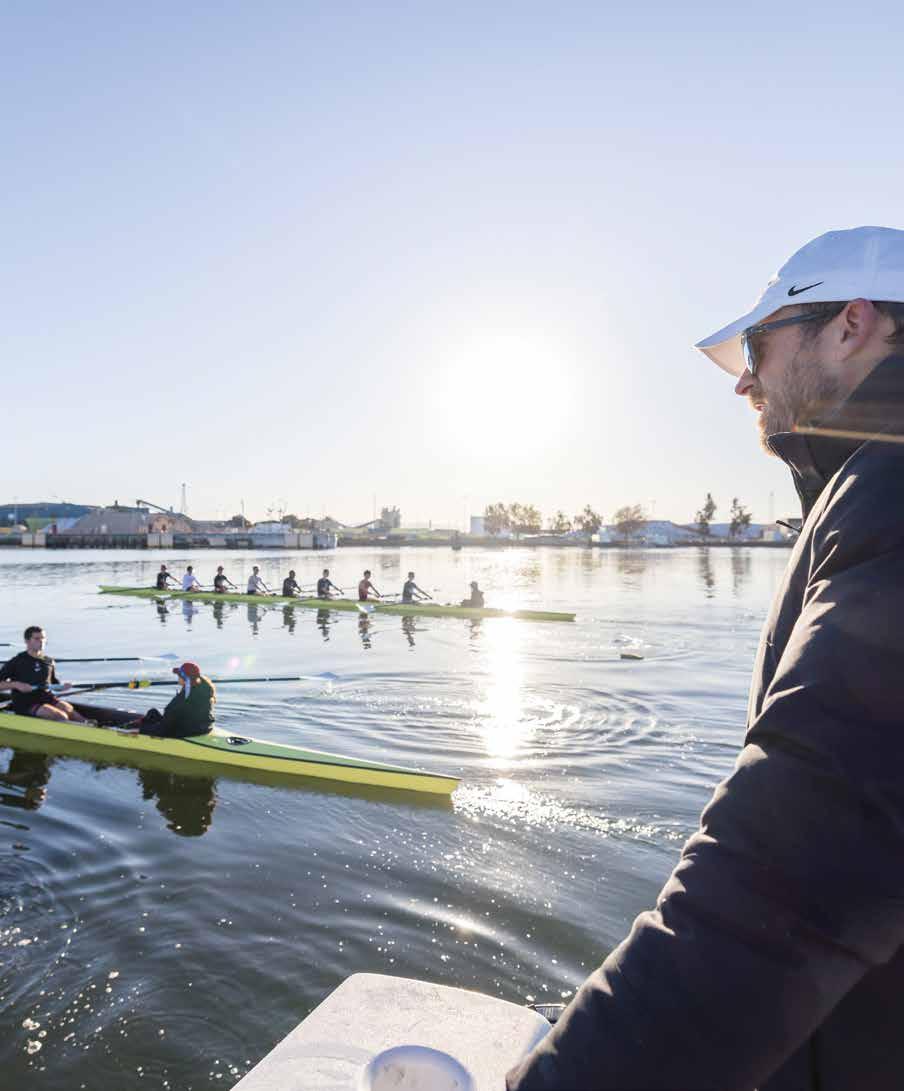
STAY WITH THE BOAT
NEVER SWIM TO SHORE: SAFETY RULES
WHAT
RESURRECTION
STANFORD MEN’S ROWING IS BACK FROM THE DEAD, BIGGER AND STRONGER
THE SAFETY ISSUE
EAT TO WIN
AND WHEN YOU EAT MATTERS
USA $9.95 CAN $12.95 APRIL 2024 VOLUME 31 NUMBER 03
Road to Paris brought to you by Gemini


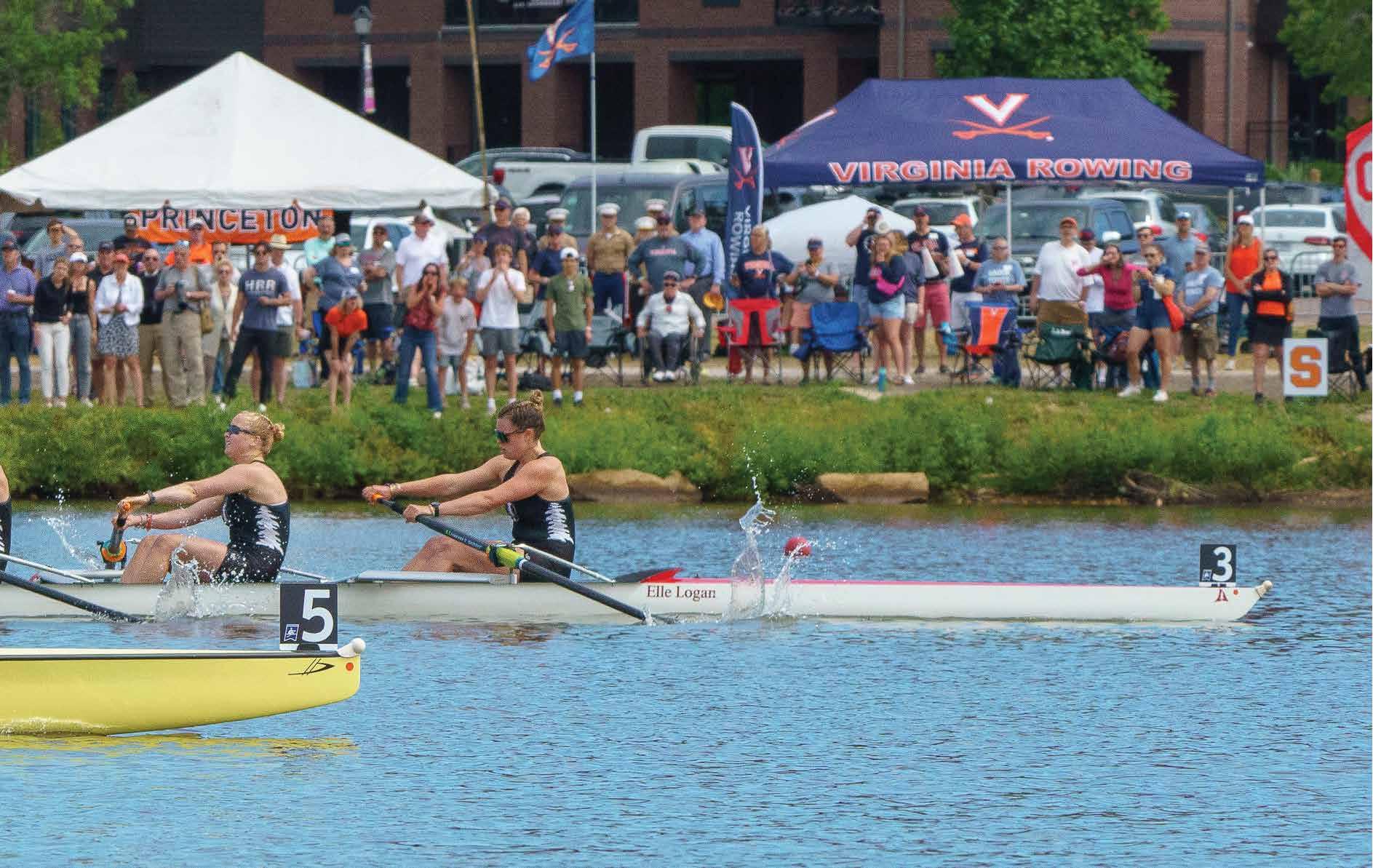

#beashark







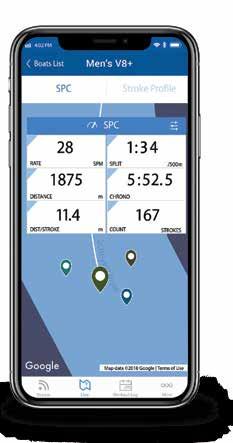



CoxBox GPS With a large, fully sealed battery, the CoxBox GPS runs longer between charges than any other rugged audio products on the market.
Do even more with LiNK Logbook’s Team accounts and wireless streaming to the cloud. Compare boats, even seats, in real time. Or allow anonymous workouts for the crew. Whatever works best for you. www.nksports.com Sign up for the NK Sports Newsletter for special deals and insider information! NK SPORTS NEWSLETTER Subscribe Today!
LiNK Logbook
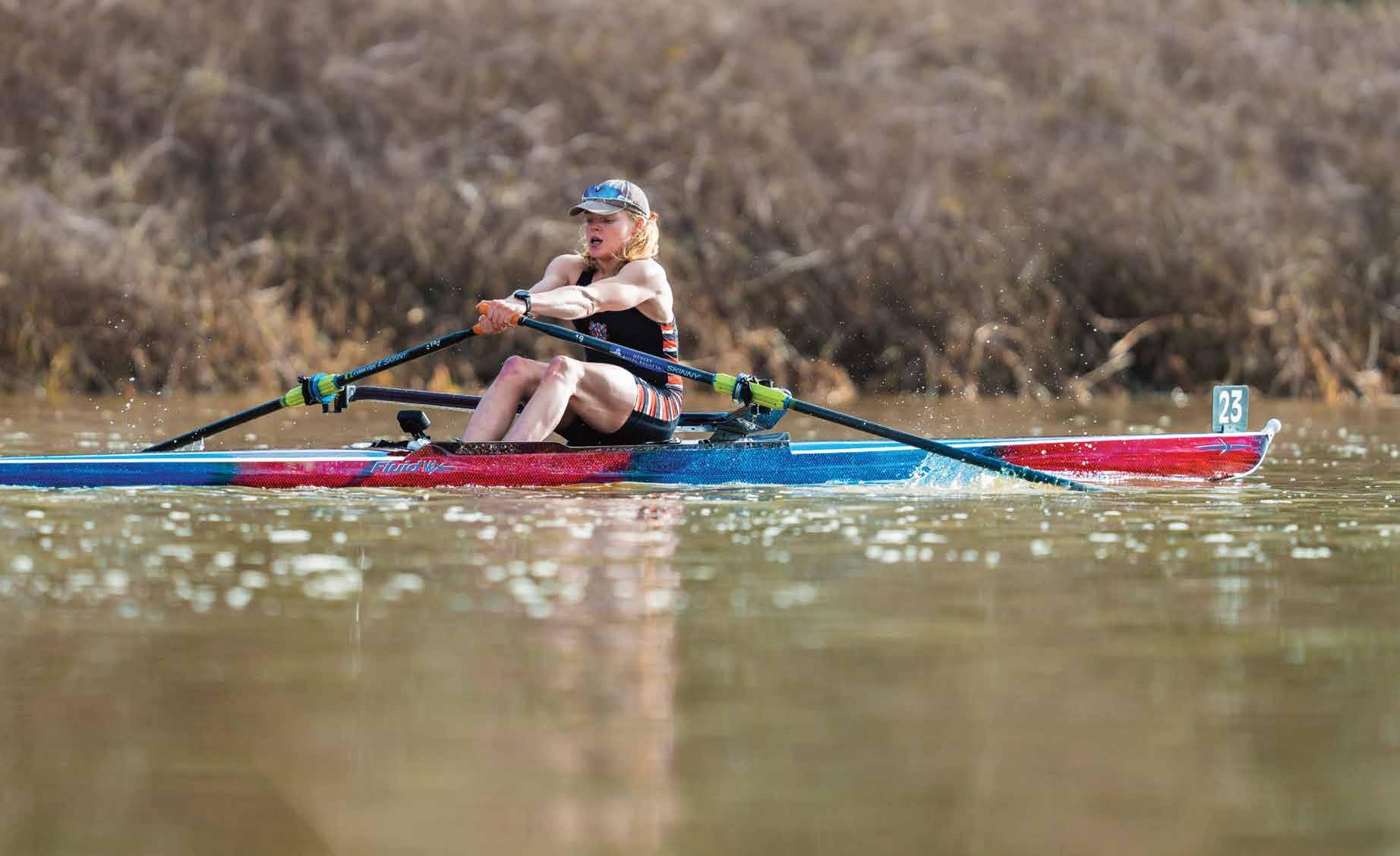





Follow us on Facebook: @Rowfluid • Instagram: rowfluidesign rowfluidesign.com
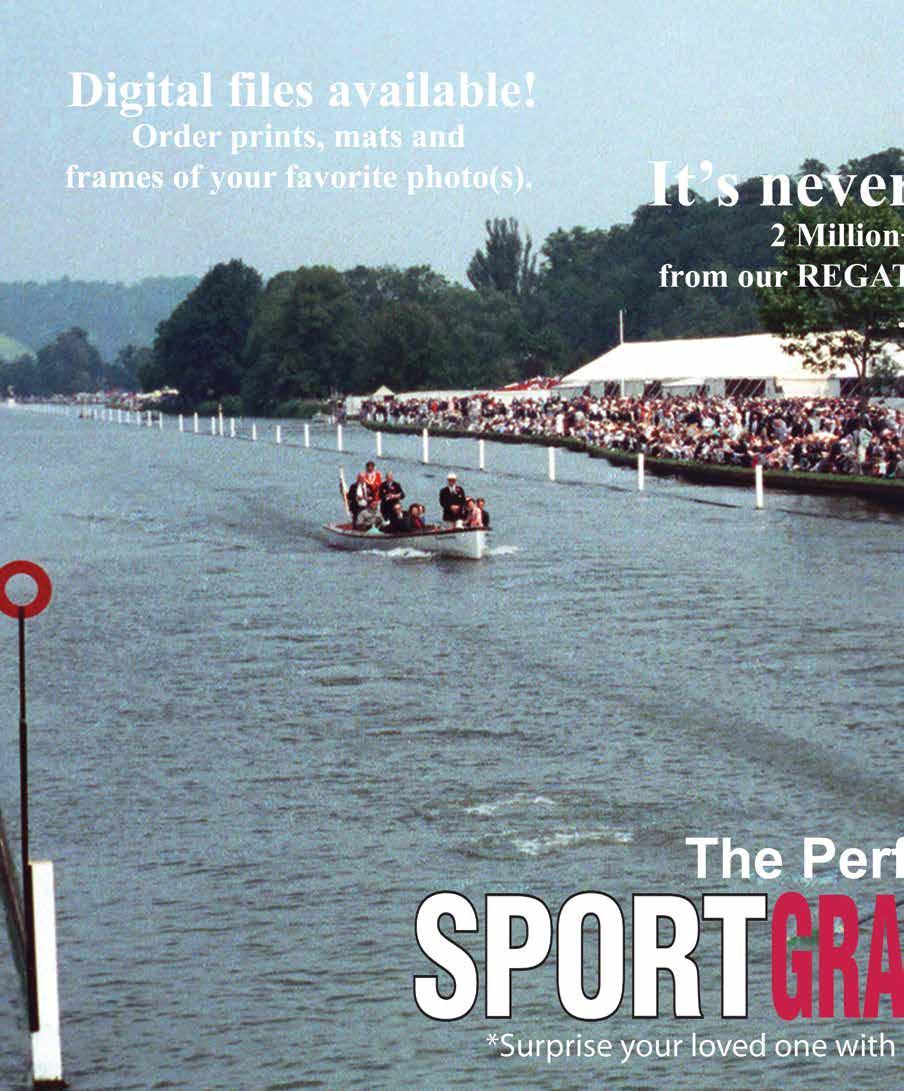

Why a light boat?
• Less drag, more speed
• Lighter feel, higher stroke rate
• Easier to carry
How did we do it?
Single skin - kevlar/carbon
No paint on deck
I-beam frame
The lightest fittings:
• Dreher/Peinert rigger - 4.3 lbs.
• Dreher seat - 15.5 oz.
• Carl Douglas tracks - 15 oz.
• Carbon footboard - 15 oz.
• H2Row shoes - 19 oz.
• Molded bow ball - 1 oz.

$9,950
25 New Carbon Rigger
lbs. 12 oz. (lightest
in production)
Peinert
25
1x
incl. options Made in USA www.sculling.com 508-758-3020




After the university tried to eliminate men’s rowing, Stanford, led by Northeastern alum Ted Sobolewski, has come back stronger, faster, and more resilient.
BY CHIP DAVIS
Clear and Present Dangers
From colliding to capsizing, in foul weather or rough water, the perils of an outdoor water sport like rowing are obvious, potentially lethal—and totally preventable.
BY MADELINE DAVIS TULLY
Tom Rooks
BY CHIP DAVIS
CONTENTS APRIL 2024 | VOLUME 31 NUMBER 03 ON THE COVER: Stanford Men’s Rowing | Photo: Matthew Huang/ISIphotos.com. DEPARTMENTS PHOTOS: TOP, SPORTGRAPHICS.COM; MIDDLE: USROWING; BOTTOM, ROWING NEWS. 25 QUICK CATCHES News USRowing Election Martin Cross Awards 57 TRAINING Sports Science Downing the Resistance Coxing Backing Into Stake Boats Best Practices You Be the Judge Fuel Eating to Win Training The Staying Power of Active Relaxation Coach Development Preaching the Value of Rowing 14 From the Editor 66 Doctor Rowing FEATURES 52 46 34 USRowing’s
Director of Safeguarding likes his job because doing the right thing morally and ethically is essential to the very survival of rowing.
Resurrection
ROWINGNEWS.COM Follow Rowing News on social media by scanning this QR code with your smart phone.
11 APRIL 2024


FROM THE EDITOR
CHIP DAVIS
One Is Too Many
The only way to succeed in rowing is to work hard and to work together. You couldn’t give a young person two better lessons. And teaching those lessons while engaging 85 percent of a body’s muscles, without concussions and blown knees, to a population whose obesity rate is closing in on 50 percent, couldn’t come at a better time.
The key is not to kill any of them in the process.
That’s intentionally dramatic because the point needs to be made: No one, especially youths who aren’t able to make grownup decisions yet, should ever die from rowing. Our sport is a lifesaver for many; it should never be the reason anyone—and one is too many—is killed.
No one, especially youths who aren’t able to make grown-up decisions yet, should ever die from rowing.

Yes, we sometimes lose our teammates and friends to heart failure, seizures, and strokes while they’re rowing. Those undiagnosed and unpredictable causes of death exist always in the background of everything we do. Drownings, lightning strikes, collisions, and other totally avoidable causes of death are what should never happen, and as long as they do, we are not doing our sport right.
Just ask Tom Rooks—as we did for this, The Safety Issue, in Madeline Davis Tully’s latest excellent feature story on safety in rowing on page 46 and in the Rowing News interview with Rooks on page 52. He’ll tell you: Taking risks is acceptable, taking chances is not.
Our editorial team can be reached at editor@rowingnews.com
PHOTO: LISA WORTHY
14 APRIL 2024
It happens to some of the best, even in good conditions.

W8+ USA, Silver medal World Rowing Championships 2023 Mould F42 Riggers Aliante carbon The Choice of Team USA ELITE ROWING Filippi USA Official Dealer info@eliterowing.com (617) 783-8442 www.eliterowing.com
LETTERS
Insulting Mismatch
In the March issue, the article “Recovering from a Substandard Row” is illustrated with a photo of Audrey Boersen taken at the speed order in February where she won the B final as a lightweight woman competing against a large field of openweights. She later did not get chosen for Olympic Selection Camp, even though people who had lost to her in the B Final were. She was the only person in the B Final not selected for camp. On top of that, a woman in the C final was selected over her.
Pairing the photo of her with that headline is a mismatch that’s insulting and in poor taste. Audrey’s row wasn’t substandard; it was inspired! She’s a lightweight who won the B final ahead of the majority of openweight scullers, yet the headline under her photo implies failure.
Charlotte Copp
Portland, Oregon
Refs Should Be Paid
Madeline Davis Tully makes a few good points in “The Looming Ref Crisis,” but I have to take exception to the photo that accompanied the article.
With such an inflammatory headline, selecting a photo of one of the best and most recognized referees globally (Ruth Macnamara) was an insult that smacked of both ageism and sexism. How would the author have reacted had her photo been displayed prominently in an article on coaching that enumerated the faults and disasters of all coaches? Not well, I would think.
As for USRowing’s response to the crisis, why don’t they require regattas to pay referees? What other collegiate or highschool sport doesn’t pay or evaluate its corps? My 17-year-old nephew makes more money officiating pee-wee soccer and basketball games in a weekend than I make in a year of umpiring. And U.S. Olympic and National Team trials? At arguably the most significant regattas for our national governing body, the referees receive no compensation at all.
In terms of recruitment, it would be
wonderful to see the U.S. bring in former elite-level competitors to its referee pool, much as other countries do. One need look only to the UK with its very experienced and competent corps as a prime example.
I am supportive of the need for change that USRowing recognizes. I hope it can happen sooner rather than later.
Full disclosure: I have been a referee since 1999, when I was still competing for the U.S. as a National Team athlete, and I got my start at the old Saturday Night Sprints in Worcester years before I would ever race with red-white-and-blue blades. Making “my sport” the best it can be was then and continues to be my motivating factor.
Linda Muri Hanover, N.H.
From The Editor:
Wrtiers do not select the images that accompany the articles they write. We pick photographs that illustrate the subject matter, add a visual element to the story being told, and are available. The people coincidentally shown in images meant to illustrate generally a story are not the subject of the article.
—Chip Davis
They Deserve More
Kudos to Madeline Davis Tully for her excellent article on the ref crisis in rowing.
As co-director and director of the Diamond State Masters Regatta for over 30 years, I am fully aware of the important role refs play in the successful and safe administration of regattas. In fact, Madeline should have emphasized safety even more.
Our dedicated refs performed very well under the capable leadership of several different chief refs and worked pro bono until the last 10 years or so. And I mean work —six to eight hours in unforgiving heat and sometimes rain while confined in an uncomfortable launch. They deserve more congratulations and compensation.
John R. Schoonover
Retired director
Diamond State Masters Regatta Wilmington, Del.
Dreadful Participation
USRowing recently held elections for three positions: two referee coordinators and a central regional representative. Member organizations in good standing were eligible to vote. Voting participation for these positions was dreadful.
• Central Regional Representative: 332 eligible member clubs, only 85 clubs voted;
• Southeast Referee Regional Coordinator: 87 eligible member clubs, only 41 voted;
• Southwest Referee Regional Coordinator: 57 eligible member clubs, only 19 voted.
These member organizations represent thousands of athletes, yet only 30 percent of the members voted. The question is: Why do so few vote?
We urge the board of directors to analyze election data, assess why engagement in the voting process is so low, and create a plan to address this low level of engagement immediately. USRowing needs to do a better job of connecting with voting members, confirming contact information, making all candidates available to meet with voters (e.g., Zoom meetings, email outreach), and taking responsibility for addressing voting apathy.
If you are a voting member and were not notified of this latest vote, please contact the USRowing board of directors and voice your concern.
USRowing does a good job of collecting member dues. It should do an equally good job of turning out the vote.
ICONS Rowing
Carol Brown, OLY
Valerie McClain, OLY
Mary I. O’Connor, M.D., OLY
Jan Palchikoff, OLY
Anne Simpson, Captain
Letters to the Editor can be sent to editor@rowingnews.com 16 APRIL 2024


Cavalier Rowing Camp provides comprehensive individual technical feedback for sculling and sweeping in a supportive, fun environment from the championship staff at University of Virginia. Camp open to girls of all skill levels, Virginia. Camp open to girls of all skill levels, ages 13-18, who have graduated 8th grade.
Sessions:
June 17-21
July 22-26, July 27-31
Testimonials
“The Cavalier Rowing Camp was an awesome experience!! It really helped me grow in my abilities and to prepare for the upcoming season. Plus, I got to meet some pretty awesome coaches and rowers. It was definitely the highlight of my summer!”
“The Cavalier Rowing Camp offered a great balance between learning new technique and high quality reps while also offering fun activities and a welcoming environment. The coach-to-athlete balance allowed me to receive consistent, thoughtful feedback throughout each session. This was a perfect opportunity to grow in skill and love for the sport!”
“It’s been 10 years since I first started with rowing and it all began at the Cavalier Rowing Camp. It was a great opportunity to learn new skills and sharpen up before my home team’s fall season. The staff provided top-level coaching as well as invaluable exposure to a University campus. I’ll always remember the first time I walked through the UVa boathouse looking at all the banners and achievements on the wall and how inspired I felt.”
Visit www.cavalierrowingcamps.com or email cavalierrowingcamps@virginia.edu
for more information

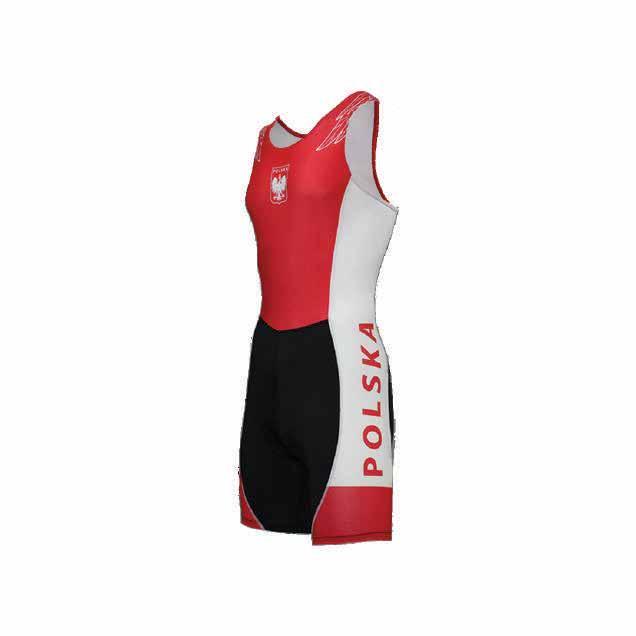
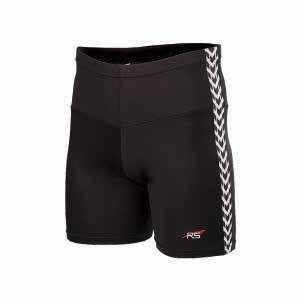
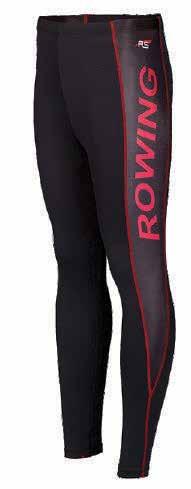
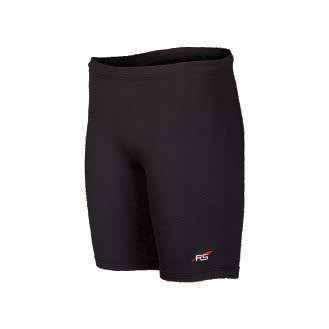
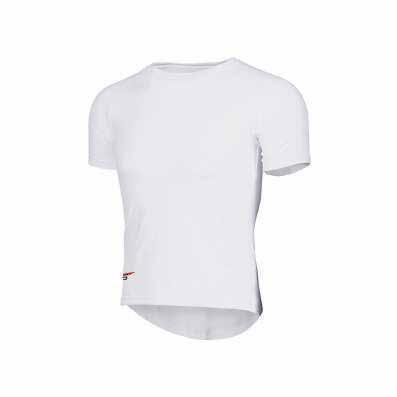

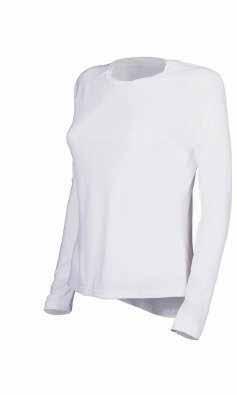

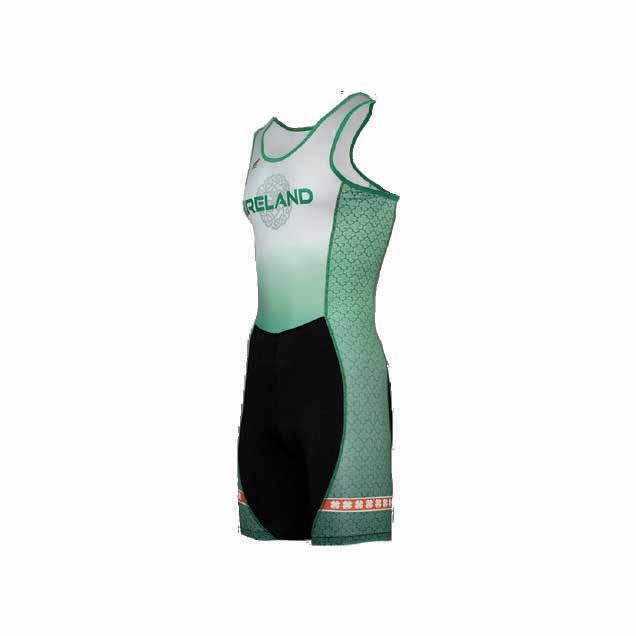

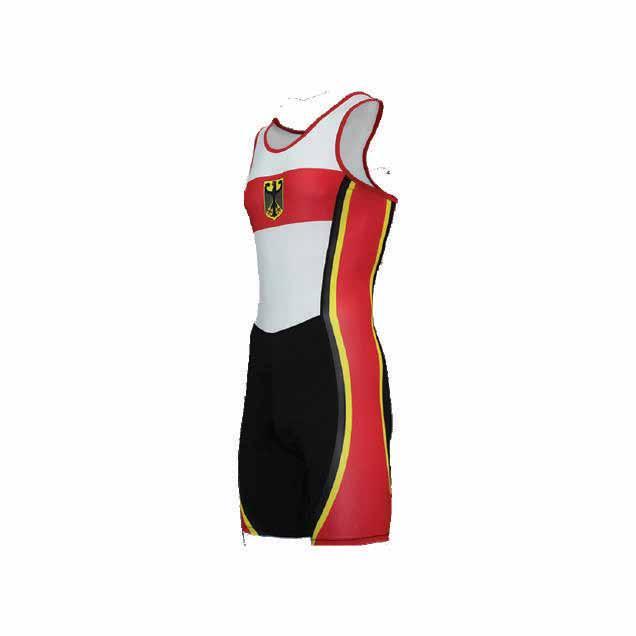
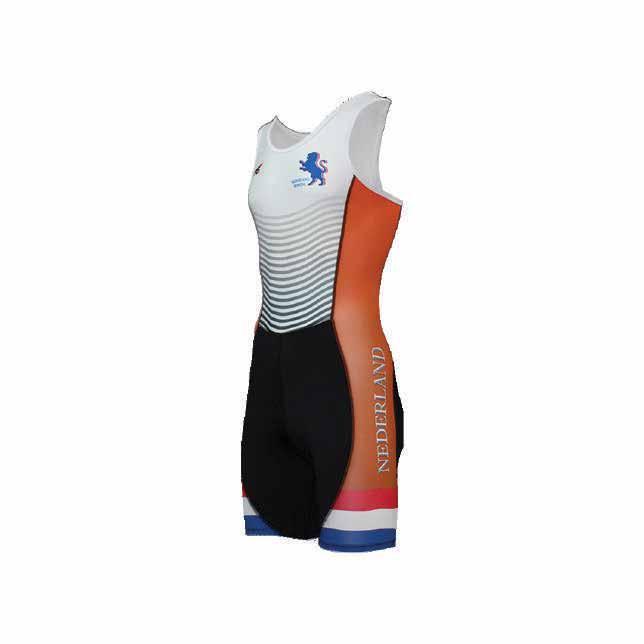


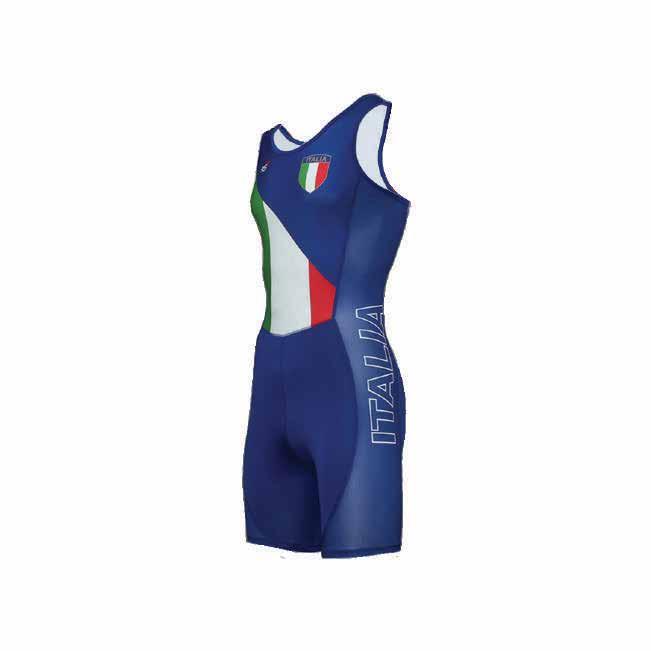
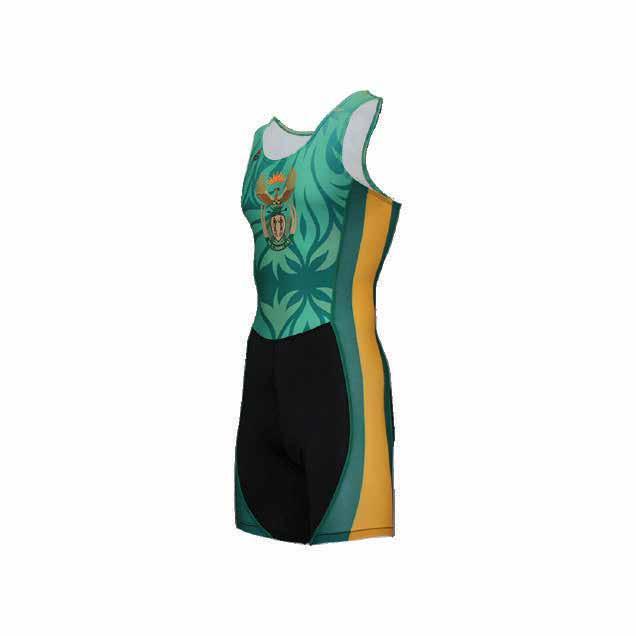


20 APRIL 2024
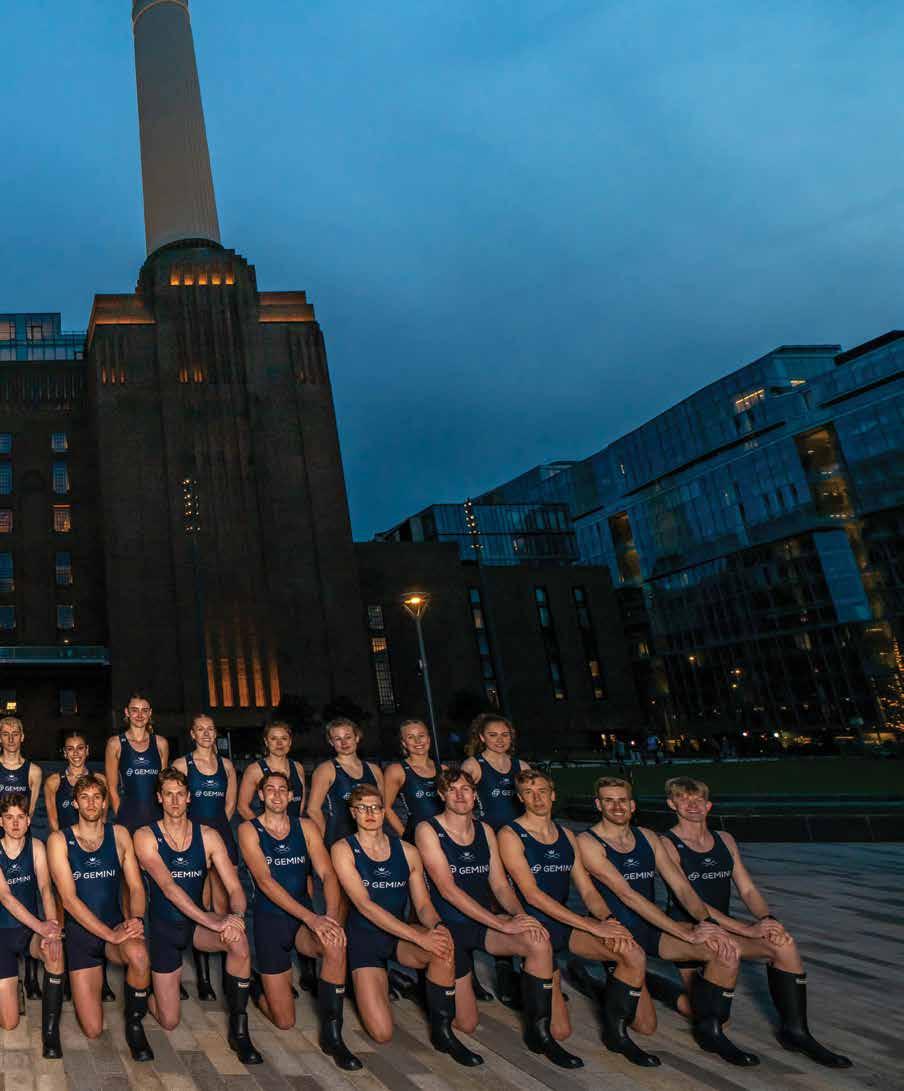
Blues Crews
The crews for the Gemini Boat Race 2024 were unveiled at an announcement event held at the Battersea Power Station on March 13. The university boat clubs of Oxford and Cambridge revealed the 36 student rowers who will compete in one the world’s original intercollegiate sporting events. Forty years after the power station was decommissioned, the historic building is now home to hundreds of shops, bars, restaurants, apartments, offices, and entertainment venues.
PHOTO: BRCL/ROW360
21 APRIL 2024


That’s a Wrap
Junior rowers de-rig and wrap their shells for the trip home following the OARS Youth Invitational Regatta in early March. Orlando Area Rowing Society has hosted the OARS Invitational Regatta for 26 years in central Florida, welcoming 28 clubs and 1,500-plus rowers and thousands of spectators from Florida, Georgia, and beyond.
PHOTO: LISA WORTHY
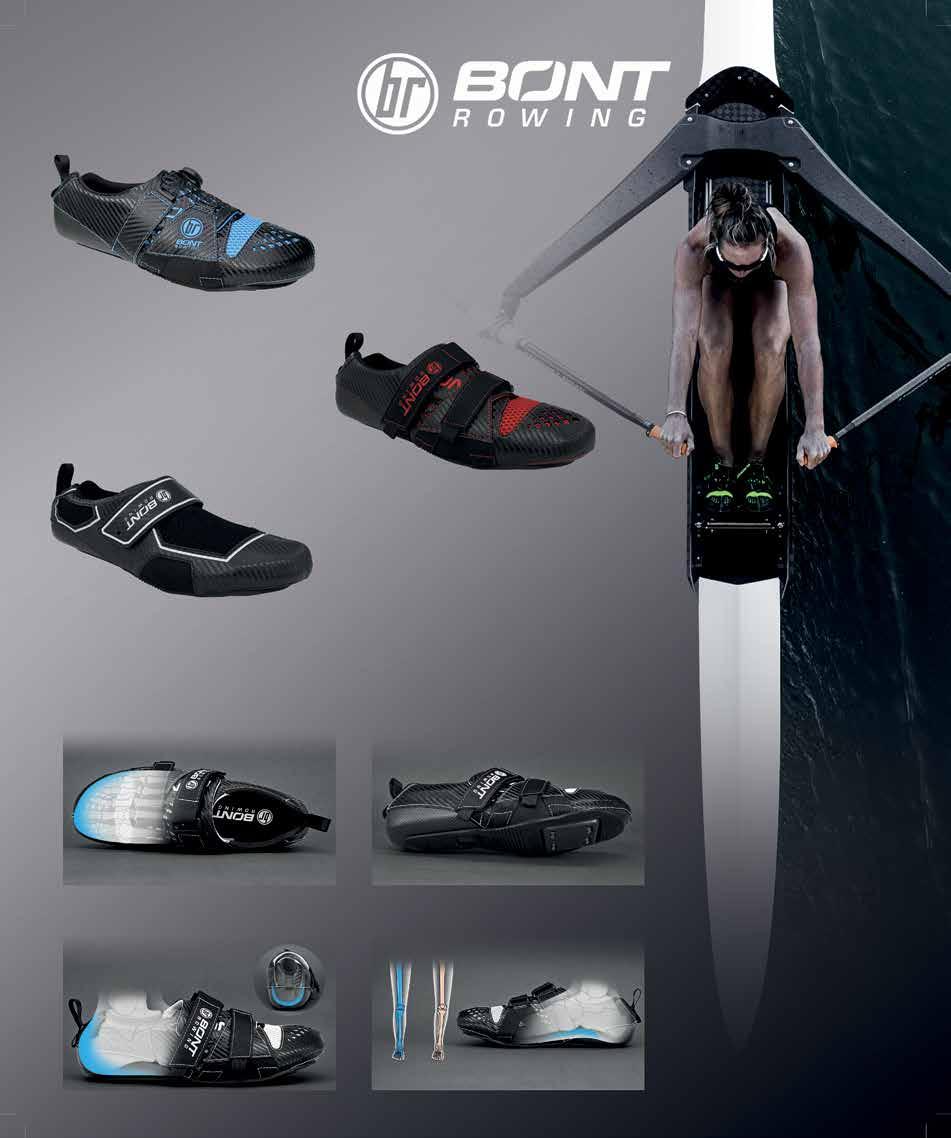


Structural Arch Suppor t
Anatomical Heel Cup
T H E C H O I C E O F C H A M P I O N S b o n t r o w i n g . c o m
Anatomical Forefoot Carbon Fiber Split Sole Science, Built In.



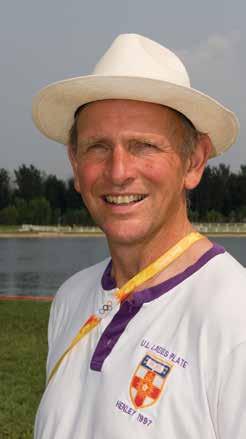
Martin Cross to Call 2024 IRA Broadcast
This year’s IRA broadcast will feature a familiar but foreign voice as Martin Cross brings his highly esteemed talent as rowing commentator to the collegiate national-championship regatta. We continue to work to improve our broadcast quality, both technologically and with the best people available,” said IRA Commissioner Gary Caldwell. The 2024 IRA National Championship Regatta takes place from May 31 to June 2 on Mercer Lake, N.J., and will stream live online.
QUICK CATCHES
Election Reveals USRowing Lacks Transparency and Accountability
Low
voter turnout, scanty minutes, record revenue yet big losses, high pay yet poor results—but USRowing board stays the course.
USRowing held an election this winter for the Central Regional Representative to its board of directors, a seat won by incumbent Marnie Stahl.
Elections for two non-board positions also were held. Elaine Roden was elected Southeast Referee Regional Coordinator, and Bryan Fraser was elected Southwest Referee Regional Coordinator in an uncontested race.
A total of 145 votes were cast across the three contests from among the 75,000 members of the association recognized by the United States Olympic and Paralympic Committee as the national governing body of rowing.
“We want to ensure everyone understands the process,” said USRowing CEO Amanda Kraus in response to inquiries about the low turnout.
“The regional directors are not elected by our 75,000 plus individual members but by the 1,400 organizational members, each of which holds one vote. We have dedicated significant efforts to ensure effective communication about the election process.”
“Either people didn’t know about the election or didn’t care,” said Ben Boehm, who, along with Stahl and Mary O’Connor, ran for the central-region board seat in the election, which drew 85 total votes. “I just don’t know that USRowing is superconnected to their rowers. This election may be indicative of that.”
Boehm, a retired Air Force colonel who rowed at MIT and now serves as head coach of the Greater Dayton Rowing Association, continued, “I have skill sets that I thought would be valuable to the organization and to our region. The central region stretches from Florida all the way to Ohio. We don’t really feel much love from USRowing.”
Regional directors hold four of the 12 seats on USRowing’s board. Two types of athlete representatives (recent U.S. National
Team members elected by their teammates) hold four seats, and at-large directors elected by the board itself hold the remaining four. Two previous directly elected men’s and women’s vice-president seats were eliminated when the bylaws were changed to reduce the board from 14 to 12 directors in 2021.
Individual members of the association are not allowed to attend board meetings, and the minutes of board meetings are scant. The published minutes of the last board meeting of 2023 were under 300 words—including roll call—and disclosed little of substance.
Example: “The board then followed its agreed procedure … getting input from Ms. Kraus as to her thoughts, and then deliberating in executive session. After expressing their views, Mr. Pritzker and Ms. Stahl left the meeting at approximately 1 p.m. The board concluded its meeting.”
Board minutes “are crafted following best practices, with guidance from our secretary, who is also an attorney,” wrote Kraus. “The objective is to capture essential details such as attendance, decisions made, and actions taken, without delving into exhaustive transcripts of discussions. This approach is intended to provide clarity and transparency while respecting the practicalities of documentation. If there are any specific questions or feedback regarding our governance, we welcome them.”
The only time each year members of the association may gather and provide input to the board of directors is at the annual meeting, USRowing’s current bylaws state. The last such meeting was held more than a year ago—in February 2023.
The 2024 meeting “will be scheduled in due course,” wrote newly elected board chair Kirsten Feldman in response to questions from Rowing News. Feldman said she is committed to hearing from “stakeholders” as she embarks
25 APRIL 2024
BIG NEWS
PHOTO: PETER SPURRIER.
USROWING ELECTION | MARTIN CROSS | AWARDS >>> CONTINUES ON PAGE 26
Martin Cross, working at the 2008 Olympic Games

Steve Gladstone’s Youth Rowing Clinic & Coaches Symposium
on a “listening tour.”
“USRowing has been steadfast in its commitment to increasing transparency, supporting our membership, strengthening financial resources, improving member communication and engagement, and enhancing our high-performance programs,” wrote Feldman.
In 2022, the most recent year for which financial statements are available, USRowing
USRowing’s directors have stuck with Kraus, the highest-paid CEO in USRowing history during its worst-performing period.

collected a record $14.3 million in revenue from the rowing community, mostly through dues and fees, despite having fewer members by thousands than before the pandemic. USRowing lost $147,850 in 2022. That year was also the sport’s worst in terms of safety,
Since 2019, American crews rowing under the aegis of USRowing haven’t won a single event—out of 29, per year—at the World Rowing Championships, and the U.S. didn’t win a single medal of any color at the
Through it all, USRowing’s directors have stuck with Kraus, their CEO since 2020, who, according to the association’s Form 990 for 2022, took home over $300,000 in compensation, making her the highest-paid CEO in USRowing history during its worst-performing period.
USRowing’s “Vision Statement,” promulgated in October 2021, declared that the board’s role is to “guide the CEO and the management team in reforming the operations of USRA and to provide a baseline
It states further that the board “encourages critical and constructive
“We fully support the direction of the organization and the leadership’s focus on our three key pillars: performance, inclusion, and experience,” wrote Feldman. “We look forward to continuing our efforts in these areas to achieve our shared goals.”
CHIP DAVIS
APRIL 2024
QUICK CATCHES
BIG NEWS >>>
Clinic
hone their fitness, improve their technical skills, and practice important mental training components,
training session,
well as participate in round table discussions
craft. Scan to Learn More
ROWERS Rowers attending the
will
under the direction of Coach Steve Gladstone. COACHES Youth, Masters, and College Coaches attending the Symposium will shadow Coach Gladstone in each
as
focused on elevating their coaching

Schoch Wins USRowing’s 2023 Medal of Honor
The man who made the Head of the Charles a three-day world-class event was among several stars and stalwarts honored in March for their contributions and achievements.
Fred Schoch, a pillar of the rowing community who led the Head of the Charles Regatta for 33 years, is the winner of the 2023 Medal of Honor, USRowing announced in March.
It’s the highest accolade the sport’s national governing body can bestow, and Schoch, a University of Washington graduate who retired as executive director of the fall rowing classic last year, was among several stars and stalwarts chosen for recognition by USRowing’s board of directors.
The other honorees: Ron Chen, Bill Manning, Steady State Network, Unity Boat Club, Dorothy Lazor, Ellen Minzner, and Marc Oria.
Schoch began rowing at the age of 10, coxing the crew of his father, Delos “Dutch” Schoch, an alternate for the 1936 “Boys in the Boat” Olympic team. Like his father, Fred Schoch rowed at the University of Washington, where he earned a bachelor’s degree in English and, after graduating, began his career as a teacher and rowing coach. He coached at Belmont Hill School, Connecticut College, Princeton University, the United States Naval Academy,
Georgetown University, and for the U.S. National Team.
Schoch was hired in 1990 to oversee the Head of the Charles, which had been run previously by volunteers, and began the painstaking work of building it into the world-class event it is today. Under his tenure, the Head of the Charles has grown into a three-day extravaganza that features over 12,000 athletes from 30 countries.
It draws more than 400,000 spectators and has an economic impact on the Boston area of more than $88 million. Schoch transformed the event by collaborating closely with coaches, sponsors, competitors, staff, and volunteers. He also made the regatta more inclusive by inviting Para rowers to participate, and the Charles is the only event of its size to achieve full gender equity. The regatta has contributed over $3 million to the local community. Jack Kelly Award – Ron Chen Awarded to an outstanding individual who represents the ideals that Jack Kelly exemplified: superior achievements in rowing, service to amateur athletics, and success in their chosen profession, thereby serving as an inspiration to American rowers.
This year’s Jack Kelly Award winner, Ron Chen, has had a storied rowing career as both a referee and chair of World Rowing’s Masters Commission.
A 1980 graduate of Dartmouth College, Chen got his law degree at Rutgers University, where he was dean of students at the law school from 2013 to 2018. He serves on the executive committee of the national board of the American Civil Liberties Union and as the ACLU’s general counsel and chair of its audit committee.
Chen began refereeing in 1980 and worked his first international regatta in 1987. He was a referee at the 1996 Atlanta Olympics and a vice president and board member of USRowing for nine years during the transition from Indianapolis to New Jersey. He also served as the mid-Atlantic representative, secretary, and male VP in 2007. Currently, he is board president of the Princeton National Rowing Association and he has worked with World Rowing for over 21 years, 16 of which were spent on the Masters Commission, of which he was elected chair in 2019.
His helpful involvement in the sport has contributed to major events around
27 APRIL 2024 PHOTO: ANTHONY TULLIANI.
AWARDS
Fred Schoch in the Head of the Charles office at Cambridge Boat Club.
QUICK CATCHES
the world. Athletes know him from his distinctive cadence. During his time as a referee, he has developed friendships with coaches and enjoyed the camaraderie of his fellow officials. Chen has played a significant role in the rowing and referee community for over 44 years.
John J. Carlin Service Award – Bill Manning Awarded to honor an individual who has made significant and outstanding commitments in support of rowing.
This year’s John J. Carlin Service Award winner, Bill Manning, has been involved in rowing in the United States for decades.
During his illustrious coaching career, he has developed rowers at Princeton University, Harvard University, and LaSalle University. He coached at Harvard University from 1998 to 2011 and became the associate head coach in 2011. His crews won Eastern Sprints, Henley Royal Regatta, IRA Championships, and the Harvard/Yale race numerous times.
Manning graduated from Harvard University in 1998 with a master’s degree in administration, planning, and social policy.
He coached multiple National Team crews for the 2004 Olympics, the world championships in 2004, 2005, and 2015, and the 2015 Pan American Games.
After Manning became the highperformance coach at Penn AC, the club had the most registrants in National Team selection regattas and speed orders outside of the USRowing Training Center in 2023. His coaching has produced Olympians and impacted the entire rowing community.
Anita DeFrantz Award – Steady State Network
Awarded to an individual or organization achieving measurable success in expanding diversity opportunities in rowing.
The winners of the Anita DeFrantz award, Tara Morgan and Rachel Freedman, have exemplified the values of Anita DeFrantz with the Steady State Network and have done exceptional work in
expanding diversity in rowing.
They embody the idea that rowing should be accessible to all and be as diverse as our communities. They have used their platform and podcast to shine a light on coaches, athletes, and teams that are doing excellent work in the rowing community. They created a podcast series that addresses diversity at every level of rowing, from rower to coxswain to coach. They deal with issues of race, gender diversity, people with different abilities and disabilities, financial insecurity, and the challenges rowers face every day.
Their creation of the Changemaker Scholarship has provided coaches from diverse minority communities with educational opportunities. The Steady State Network also has sponsored the creation of Allies with Oars, which supports transgender inclusion in rowing, and a Director’s Challenge Boat at the Head of the Charles 2023 to promote the visibility of LGBTQ+ rowers.
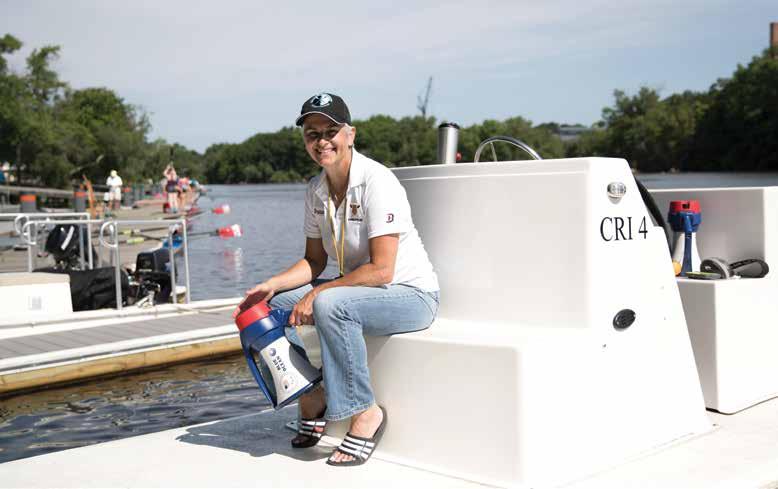
28 APRIL 2024
PHOTO: CHRISTOPHER CARDOZA.
Ernestine Bayer Award winner Ellen Minzner on the Charles River at Community Rowing in Brighton, Mass.
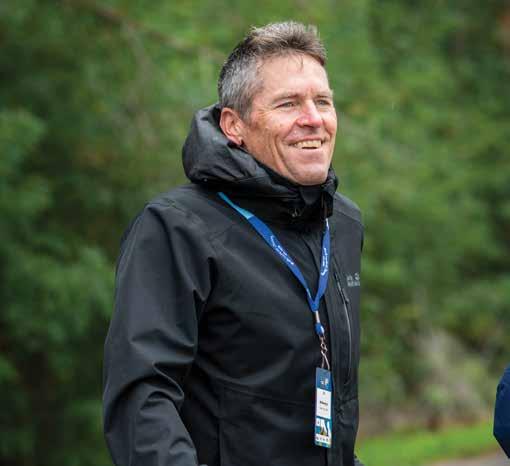
Their work has opened boathouse doors for athletes and coaches around the country and helped make the rowing community a safer, more accepting place for everyone.
Isabel Bohn Award – Unity Boat Club Awarded to an individual or organization achieving measurable success in expanding rowing opportunities for those with physical and intellectual disabilities.
Unity Boat Club is the recipient of the Isabel Bohn Award for its work in providing access to rowing for athletes with intellectual and developmental disabilities. While based in Washington, D.C., the program has rowers and coaches across the country.
Unity Boat Club’s central mission is to unlock potential through unity and inclusion, and its approach to enriching the lives of athletes is three-pronged:
1. Providing a safe space for athletes with intellectual or developmental disabilities to be themselves, grow, and improve their overall well-being, both
mentally and physically.
2. Making the sport accessible to athletes in socio-economic circumstances that would otherwise prevent them from participating and showing them that there are no limits to what they can achieve.
3. Providing military veterans with disabilities with the resources, equipment, and guidance they need to find success, strength, and camaraderie in the rowing community.
UBC also has created volunteer and peer-mentorship programs for high-school and college students. Its adaptive rowers have medaled at the highest levels of competition, including the Paralympics, world championships, Global Games, and national championships, and its program has shown how accessible rowing can be to any community.
Clayton Chapman Award – Dorothy Lazor Awarded to an outstanding individual who emulates Clayton Chapman’s 30-year stewardship of the Eastern Sprints and IRA Championships. This person will have served
Share A Link
Helping the LGBTQ+ community
find inclusive and accep�ng rowing clubs and programs, rowing retailers, boat manufacturers, and so much more.
sharealink.glrf.info
Why isn’t your link listed?
Join GLRF and share some links that you know are LGBTQ+ friendly.
Link Categories:
Clubs and Programmes
Boat Manufacturers
Oar Manufacturers
Erg Manufacturers
Rowing Retailers
Na�onal Rowing Fed.
Regional Rowing Fed.
Rowing Resources
Training Resources
Fitness Resources
Rowing 101
Gay + Lesbian Rowing Federation
GLRF.INFO
29 APRIL 2024
PHOTO: PETER SPURRIER.
John J. Carlin Service Award winner Bill Manning at the 2022 World Rowing Championships.

FROM COAST TO COAST

consistently behind the scenes in unrecognized but important roles in staging a regatta.
Dorothy Lazor has served the rowing community for years as a licensed referee and president of the Virginia Scholastic Rowing Association (VASRA), and her impact on Virginia rowers has been monumental.
She became VASRA president and regatta director in October 2014, after serving as vice president for two years. VASRA has overseen scholastic rowing in Northern Virginia and has been running regattas on the Occoquan River since 1979. Lazor is the director of all VASRA-run regattas and supports additional collegiate regattas on the Occoquan River. She has played a pivotal role in maintaining the Occoquan racecourse, which is fully buoyed and features a start platform and tower, aligner’s platform, stake boats, finish-line tower, and four docks.
Before becoming president of VASRA, Lazor served as a member of the Hylton High School Booster Board for nine years, including as vice president for four and president for one. For 13 years, she was on the Prince William Crew Association board, which manages the Oxford Boathouse, including four years as treasurer. She also was director of Prince William Crew Association summer and fall rowing programs for two years.
Her work on the Occoquan River has made the Virginia area a great place to compete for high-school and collegiate athletes.
Ernestine Bayer Award – Ellen Minzner Awarded in recognition of outstanding contributions to women’s rowing and/or to an outstanding woman in rowing.
Ellen Minzner is a highly respected and appreciated coach for rowers of all ages and abilities. Her tireless work promoting Para and adaptive rowing across the country has exemplified the belief that rowing is for everyone.
A Para-rowing pioneer, she worked at Community Rowing Inc. for more than 10 years as the director of inclusion and advocacy, where she and her team of coaches and staff pioneered a model for serving people with disabilities, military veterans, and underserved youth that has become a national standard. A communications graduate of Villanova University, she was a member of the National Team and won
QUICK CATCHES 30 APRIL 2024 P E T E R S O N A R C H I T E C T S 156 Mount Auburn Street Cambridge Massachusetts 02138 Telephone 617. 354. 2268 www.peterson-architects.com
BOATHOUSE DESIGN • ROWING TANKS • FEASIBILITY STUDIES • SITE ASSESSMENT WORK
+ PLANNING
ARCHITECTURE
FOR ROWING
Rowing Projects at: Bates College • Bergen County • Brunswick School • Culver Academies • Episcopal H.S. of Jacksonville
Paul’s School
©
Wilde
Crumpacker Boathouse
St.
Photo
Edua
gold in the lightweight double at the world championships in 1995 and 1996.
Minzner has overseen the Para National Team since 2019 as USRowing’s director of Para high performance. Her leadership has grown the Para team and resulted in great competitive success, including two medals in the PR3 double and the PR3 four with coxswain at the 2023 World Rowing Championships and a silver medal in the PR3 four with coxswain at both the 2016 and 2021 Paralympics.
Minzner is the co-chair of the Head of the Charles Announcing Committee. Her work led to the inclusion of Para events at the Head of the Charles, and the trophy given to the winner of the LTA four with coxswain was renamed the Ellen Minzner Trophy in 2021.
Man of the Year – Marc Oria
Awarded in recognition of outstanding contributions to men’s rowing and/or to an outstanding man in rowing.
As the coach of the U.S. coastalrowing team, Marc Oria has been instrumental in the growth of coastal rowing and the success of its crews. Oria has been able to take rowers accustomed to flat water and help them embrace the challenges and opportunities of coastal rowing at the highest level. He began Next Level Rowing in 2021 to support athletes who are training for both coastal and flat-water rowing.
His expertise training athletes in both disciplines has been recognized by coaches around the world. All athletes who represented the U.S. at the 2023 World Rowing Beach Sprints Finals were coached by Oria. A great example of his ability to train and coach both flat-water and coastal rowing is Annelise Hall, who represented the U.S. in 2023 in the U19 single in flatwater and in multiple U19 boats in Beach Sprints.
CHANGE THE WAY

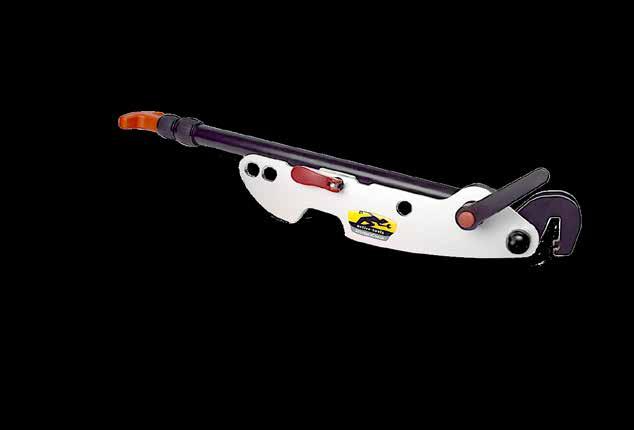

Oria competed for Spain as a lightweight rower at the U23 and senior level. A coach and educator since 1999, he was the head coach at Reial Club Maritim Barcelona in Spain, and he coached the Catalunya national team in 2006, when several of his athletes medaled at the World Rowing Under-19 Championships and the World Rowing Championships. He has a doctorate in neuroscience and is an assistant professor at the University of Cincinnati.
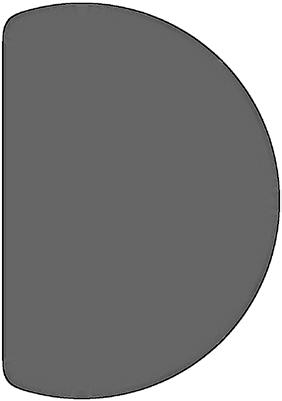
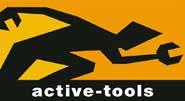
COMPENSATION GPS STREAM
31 APRIL 2024

Syracuse Alumna Named Coxswain for the 2024 Gemini Boat Race
Hannah Murphy will pilot the Cambridge women’s blue boat.
Former Syracuse University coxswain Hannah Murphy will make her debut at the 2024 Gemini Boat Race on March 30 coxing the Cambridge University women’s crew.
“We’re super-thrilled that she’s over there and going to represent herself, Syracuse University, and Cambridge University in this amazing event.” said Lucas McGee, head coach of women’s rowing at Syracuse. “It really speaks to her skills to be able to go over there in her first year and earn this seat.”
Murphy led Syracuse to the program’s first ACC-championship victory in the varsity eight last season. In the same season, she coxed the varsity eight to an eighthoverall finish at the NCAA championship and competed in the Island Challenge at the Henley Royal Regatta.
Through rough conditions, Murphy coxed the Cambridge women in Fixture
Series 2 to a clean win over Thames Rowing Club in February to advance her campaign to cox Cambridge in the Boat Race.
“To learn the Tideway and boat racing on the Tideway, a lot of times those coxswains are ones who grew up on the [Thames] and have an understanding of the stream and the stations and the turns,” McGee said. “To go over there and unseat the coxswain who was in the blue boat last year is no small feat.”
Rowing for Oxford, McGee participated in the Boat Race during the 2001-02 season, a riveting contest during which Oxford defeated Cambridge by three quarters of a length after being behind on the last turn.
“It ended up being a really historical and incredibly painful race.” McGee said. “It’s a four-and-a-quarter mile race that goes off dead level, full start, full ratings, just like it’s a 2K, and for us, that meant we
went the entire way.”
McGee has spoken to Murphy throughout the racing season, during which Cambridge has achieved promising results.
“She’s really stepped in and embraced it and is making them go fast. So it’s going to be exciting.”
The 78th annual Women’s Boat Race will occur on the famous Championship Course—a 4.25-mile stretch of the Thames in Putney. The record time of 18 minutes, 33 seconds was set by Cambridge in 2017.
The Cambridge women are coached by Paddy Ryan. They are: Gemma King (bow), Jo Matthews, Clare Hole, Jenna Armstrong (president), Carina Graf, Carys Earl, Iris Powell, Megan Lee (stroke), Hannah Murphy (cox). SKYLER
QUICK CATCHES 32 APRIL 2024
RACING
Cambridge (left) and Oxford (right) women’s crews for the 2024 Gemini Boat Race.
PHOTOS: BRCL/ROW360.
RIVERA

Now Hiring: Summer 2024 Internship

Once again, Swing is looking for college undergraduates interested in a summer spent on the front lines of venture capital, entrepreneurship, and business building.
You will be sent to fetch zero coffees, ever.
info@swing.ventures | www.swing.ventures
Interns will be based remotely, and applicants from all timezones are encouraged to apply.
An early stage venture capital fund dedicated to supporting innovation and high-impact entrepreneurs, Swing Ventures has invested across an array of industries and models including financial and health technology, consumer hardware, and e-commerce. Swing is deeply networked and well-positioned to help businesses at a variety of life stages.

info@swing.ventures
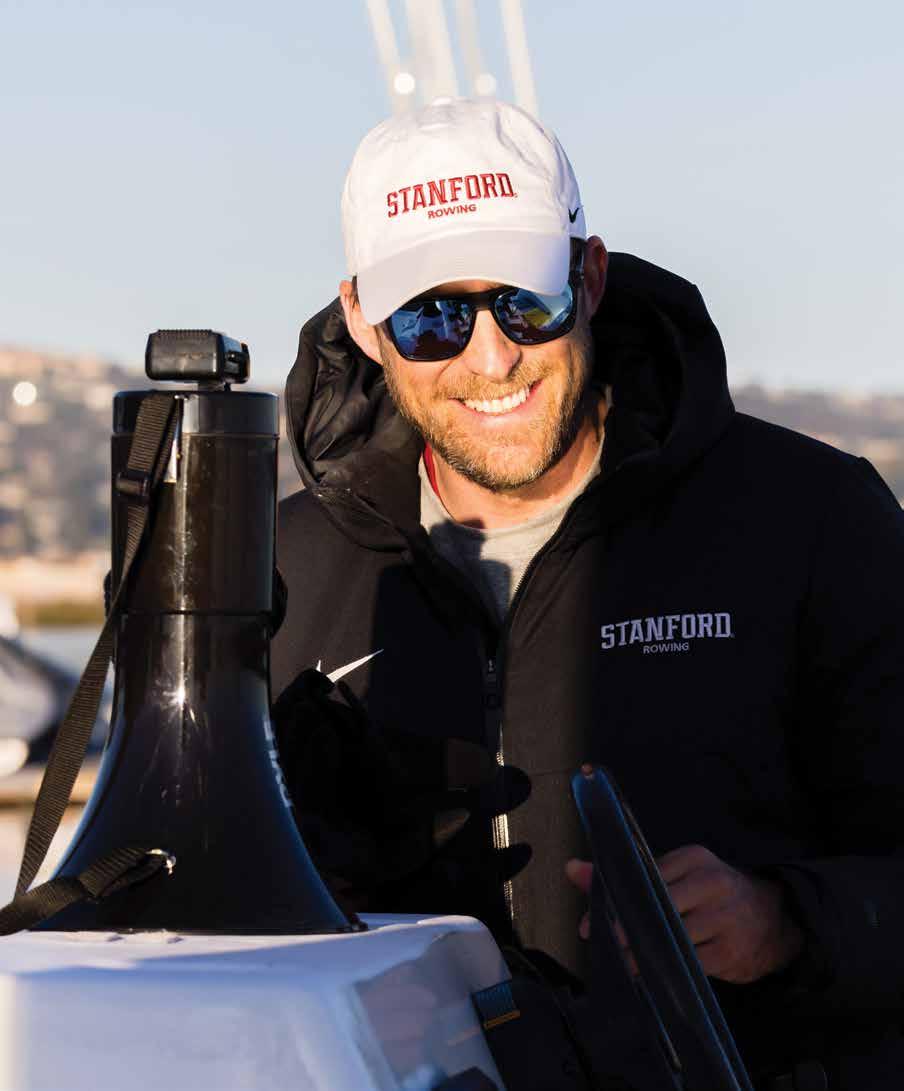
34 APRIL 2024
Ted Sobolewski likes what he sees in his young Stanford men’s crew.
RESURRECTION
AFTER THE UNIVERSITY TRIED TO ELIMINATE MEN’S ROWING, STANFORD, LED BY NORTHEASTERN ALUM TED SOBOLEWSKI, HAS COME BACK STRONGER, FASTER, AND MORE RESILIENT.
STORY BY Chip Davis
PHOTOS BY Matthew Huang/ISIphotos.com
35 APRIL 2024
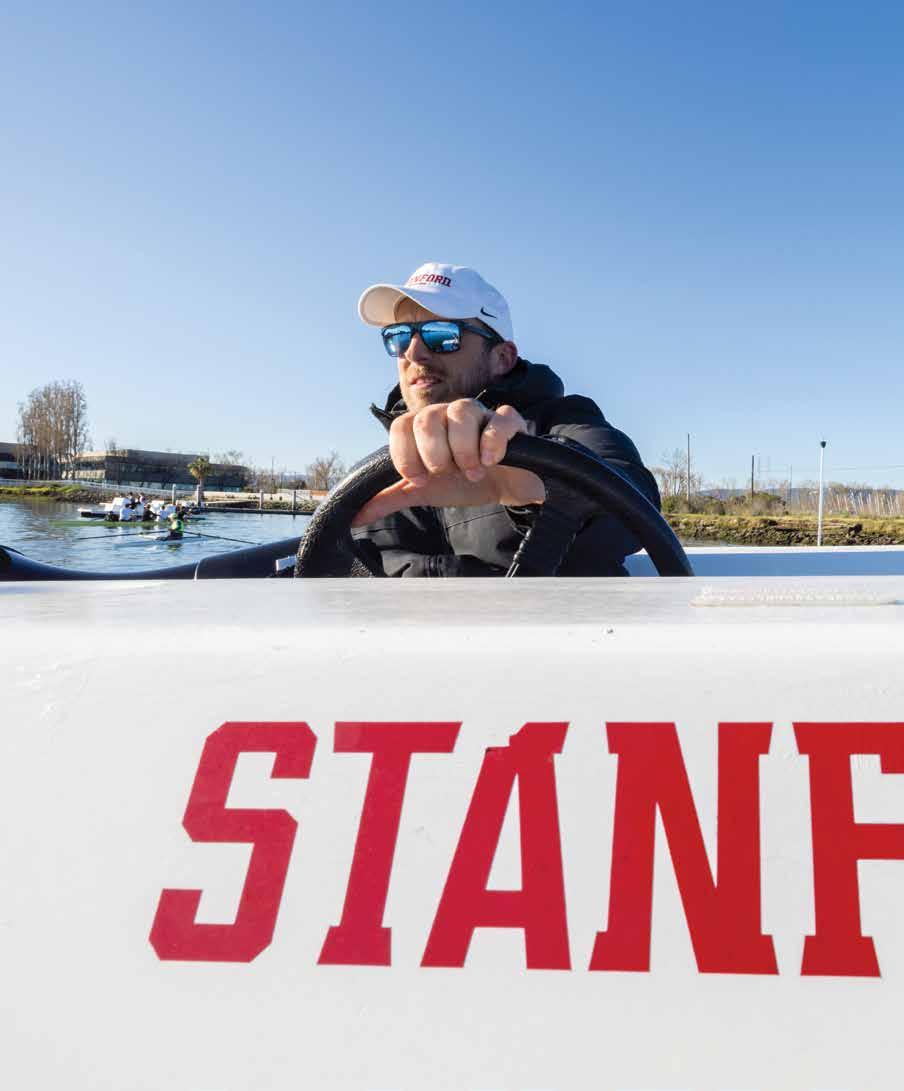
36 APRIL 2024
Ted Sobolewski has been the driving force behind a reinvigorated post-Covid and post-cancelation Stanford men’s rowing program
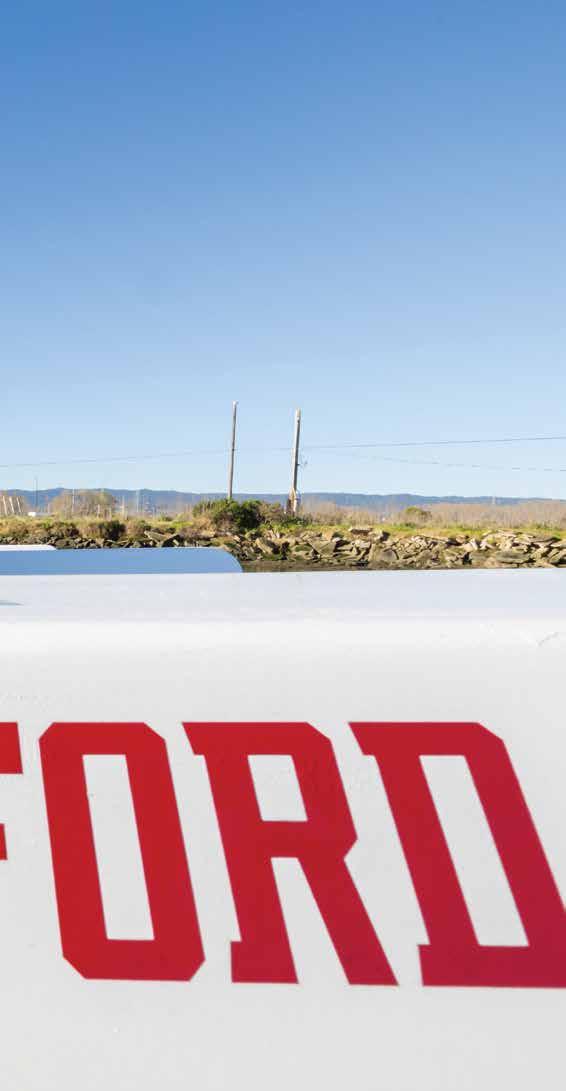
Ted Sobolewski was named Stanford’s Farwell Family Director of Men’s Rowing in the summer of 2019, just in time for Covid to cancel his first racing season.
Then it got worse.
The summer after the canceled spring season, Stanford announced that it was eliminating 11 varsity sports:
“We understand that the timing of this announcement, in early summer and against a backdrop of uncertainty and change across our country, is certainly far from ideal,” the university declared in a masterpiece of understatement.
Stanford—one of the nation’s top academic institutions and the best overall at intercollegiate athletics (26 Directors’ Cups in 29 years)—intended to cancel men’s and lightweight women’s rowing in an attempt to save money by reducing the breadth of varsity sports.
Instead of doing battle with the university, Sobolewski took a shrewder, more productive approach, similar to the collaborative, consultative way rowers at Nova Southeastern University responded to their cancellation—a sage and constructive strategy that resulted in the program’s reinstatement (Rowing News, November 2021).
Besides contacting alumni, Sobolewkski rekindled relationships with coaches who would otherwise be rivals, on the water and in recruiting, such as Al Acosta, a former rower at the University of California, Berkeley who now coaches the Cal women—Stanford’s biggest rival—and also coached Stanford’s lightweights.
“I got involved in a couple of Zoom calls and some attempts at fundraising,” Acosta recalled. “I was happy to show up and try to connect people.”
Sobolewski rowed as an undergraduate at Northeastern University from 2005 through 2008 and sculled on the U.S. Under-23 National Team in 2006 and 2007.
He began his coaching career in 2011 as a volunteer assistant under the coach who had recruited him, John Pojednic, guiding the Northeastern freshman crew to a bronze medal at the Eastern Sprints.
He then coached at Princeton National Rowing Association, leading the Mercer junior women to multiple medals at USRowing Youth Nationals and Royal Canadian Henley Regatta through 2015.
In 2016, Sobolewski returned to Northeastern, serving as Pojednic’s associate head coach through the 2019 season before
37 APRIL 2024

38 APRIL 2024
The Cardinal crews can row year-round on Redwood Creek in Redwood City, Calif.
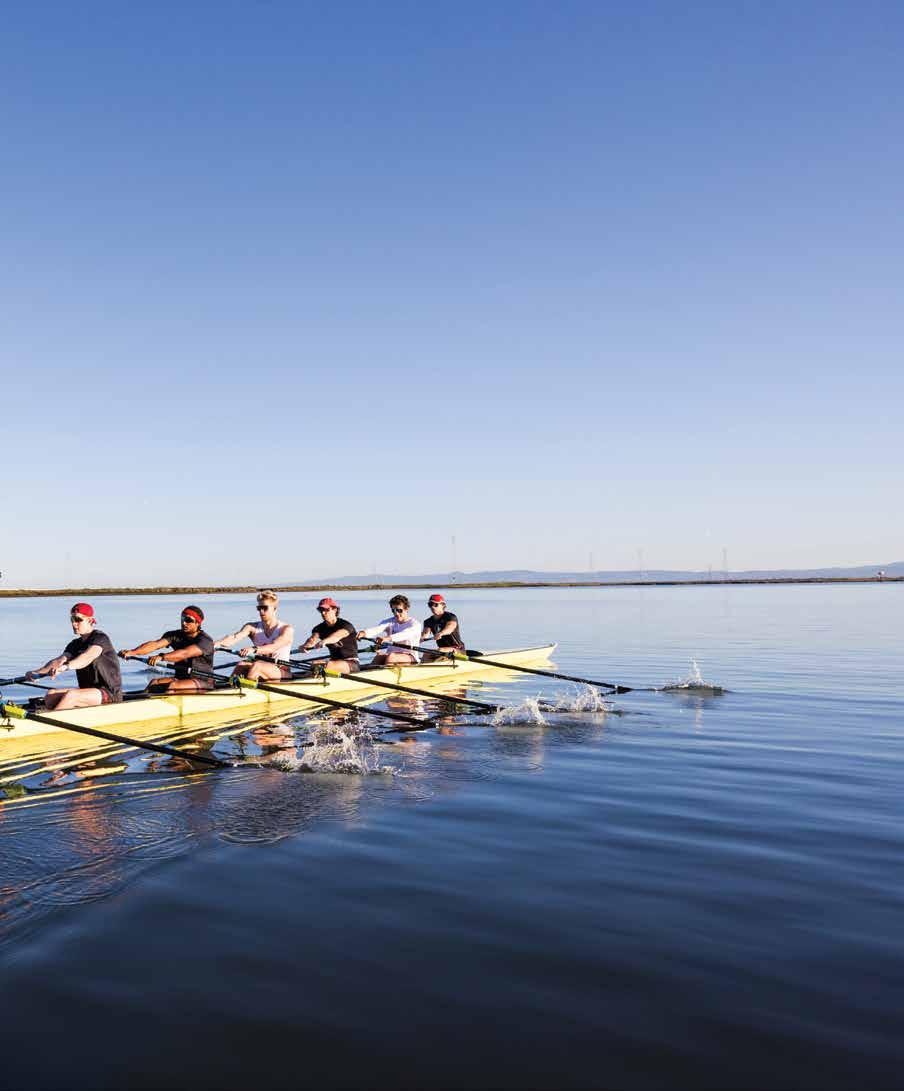
39 APRIL 2024
being named Stanford’s head men’s coach.
Pojednic was impressed by the canny behavior of his former Northeastern colleague.
“I remember sitting on the beach with my wife and reading the news ticker that Stanford had just cut sports,” he said. “The way he responded to the initial announcement was very savvy and professional, working with the university. Frankly, I never could have done it that way. I would have been pissed off and rallying the troops.
“Ted is very good at stepping out of the launch and getting right on the phone. He picked up the yoke and began pulling the wagon, getting everybody into a room, metaphorically speaking, and getting a conversation going about why this would be devastating to the sport as we know it here at Stanford.”
The Stanford rowing community responded, rallying to raise enough awareness and money to reinstate the heavyweight men’s and lightweight women’s varsity programs. (Stanford has long lacked a lightweight men’s program.)
A small number of donors gave huge financial gifts, and a large number gave smaller amounts that added up. Stanford allowed the gifts to be pooled so that the total would meet the minimum for establishing endowments. Alumni contributions financed the creation of the the Stanford Rowing Association to ensure that the programs continue.
“The alumni of Stanford rowing and Stanford University are remarkable human beings,” Pojednic said. “They invest themselves fully in the things they care about. They believe the experience of rowing, alongside the academic experience, creates remarkable people.”
With the end of college sports as we know it upon us, Stanford’s experience offers some lessons about not only how to survive a cancellation crisis but also how to emerge stronger and better equipped to succeed in the future.
Since coming back from the dead, Stanford’s heavyweight men have thrived, while Stanford’s women—both the reigning NCAA champion openweight crew (Rowing News, September, 2023) and the IRA second-place lightweights—have done even better.
“Obviously, the women’s team is unbelievable,” Pojednic said. “We’d love to
get up to speed with where the women are.”
Sobolewski is pleased and grateful.
“We have what we need to win,” he said, citing support from the athletic department in the form of a training table that’s “almost too good” and plenty of gear that’s “almost too much.”
“They’ve put themselves on a serious track,” said Paul Cooke, head coach of men’s rowing at Brown University. “They’re showing a lot of resilience, and I admire them for that. It’s good for the sport.”
In crafting Stanford’s resurrection, Sobolewski envisioned a revived heavyweight men’s program bigger and better than the one he was hired to coach before it was canceled. He credits his predecessor, Craig Amerkhanian, for establishing the team’s original endowment and for the Cardinal’s remarkable past racing successes, which were achieved with a limited roster coached by only two coaches with limited resources.
“Two things were glaring: They didn’t have enough staff members or enough coaches. It was just he and Niles [Garratt, the Alben Family Assistant Men’s Rowing Coach], kind of a skeleton crew,” Pojednic said.
They didn’t have a boatwright, a rigger, or a third coach, staples at every top college rowing program.
“Through that whole process, Ted and I were in close contact.” Pojednic said, “At first, it was kind of a joke, ‘Maybe we can get you to come out here and coach with us,’ and I was like, ‘Well, that seems a little bit far-fetched on a number of levels.’ So we just kind of joked about that for about six months.”
By the time the position was created and posted, it was anything but a joke.
“They were able to put quite a bit of support behind the position,” Pojednic said. “Eventually, I accepted.”
“It’s not just a third coach, it’s John ,” said Sobolewski. “It’s been fun.”
For Pojednic as well.
“Personally, I don’t ever want to be a head coach again,” said Pojednic, who left an unsupportive environment at Northeastern. “I really enjoy recruiting the kind of guys we’re recruiting and developing the athletes we have. Ted gives me a pretty long leash, and I really appreciate that. I get to do the things I love—building relationships with really exceptional people in the recruiting process, getting them here to Stanford, and then helping them

40 APRIL 2024
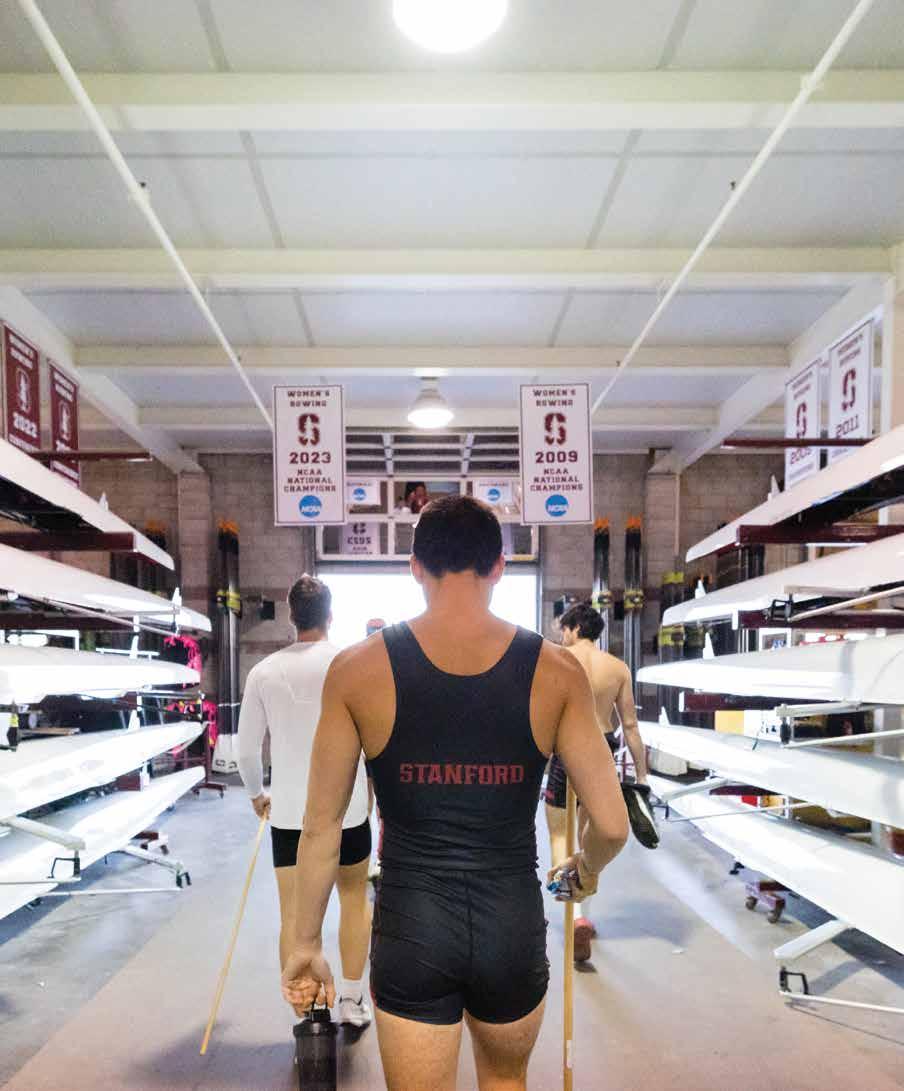
The heavyweight men share a boathouse with Stanford’s ultra-successful lightweight and NCAA women. “We’d love to get up to speed with where the women are,” says assistant coach John Pojednic
41 APRIL 2024
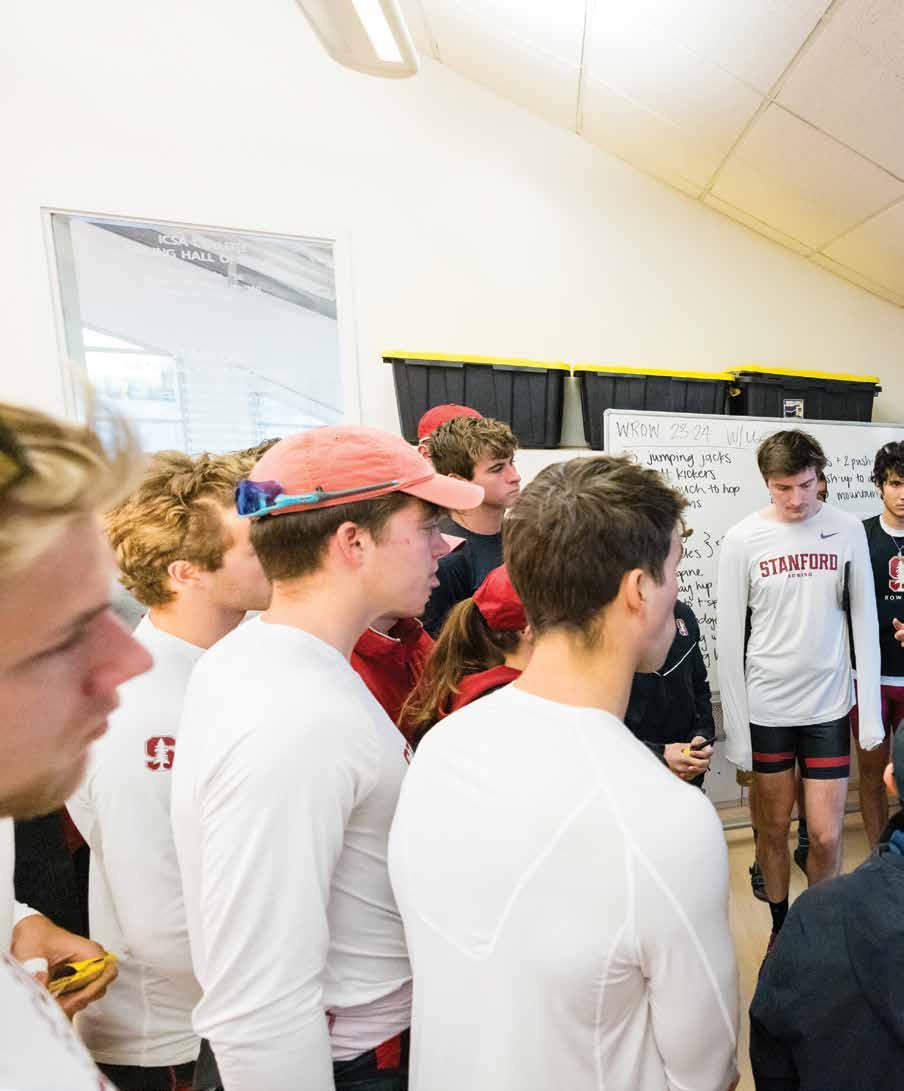
Stanford men’s head coach Ted Sobolewski says Stanford has the “most competitive two-eight environment ever. I believe in these guys.”
42 APRIL 2024
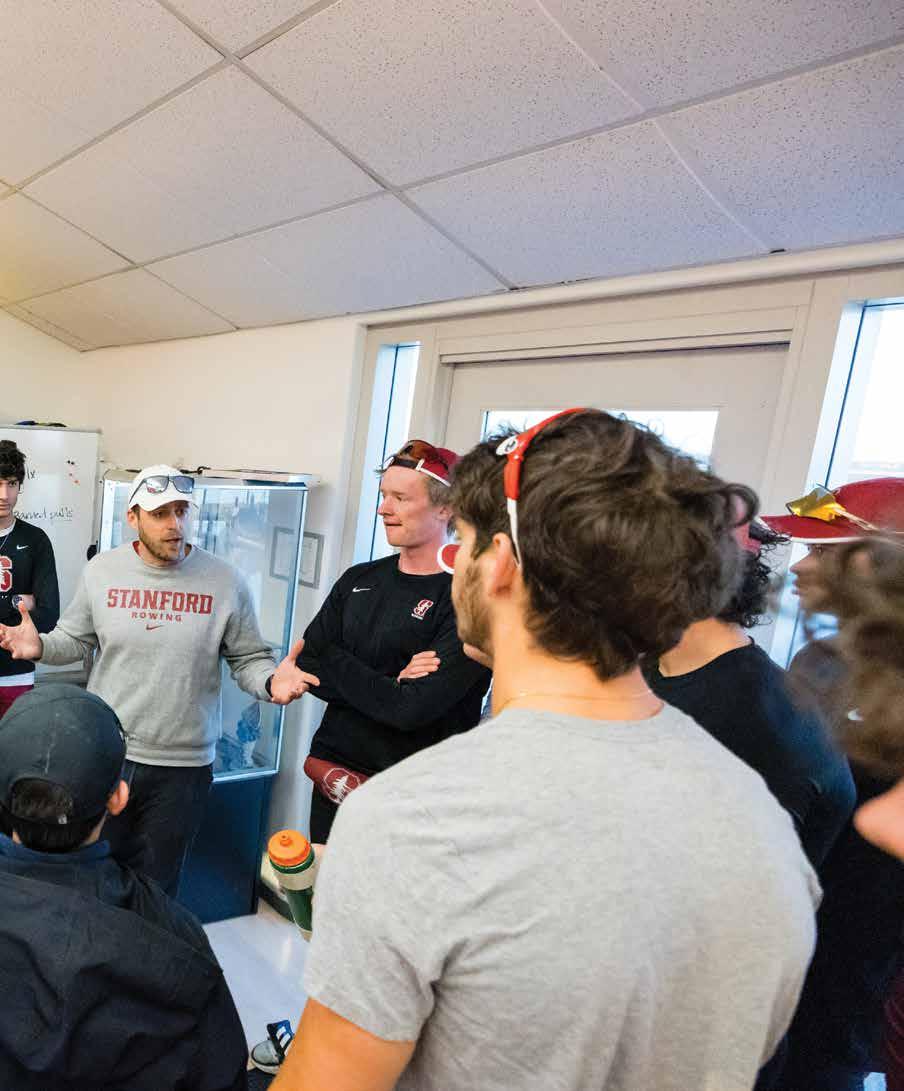
43 APRIL 2024
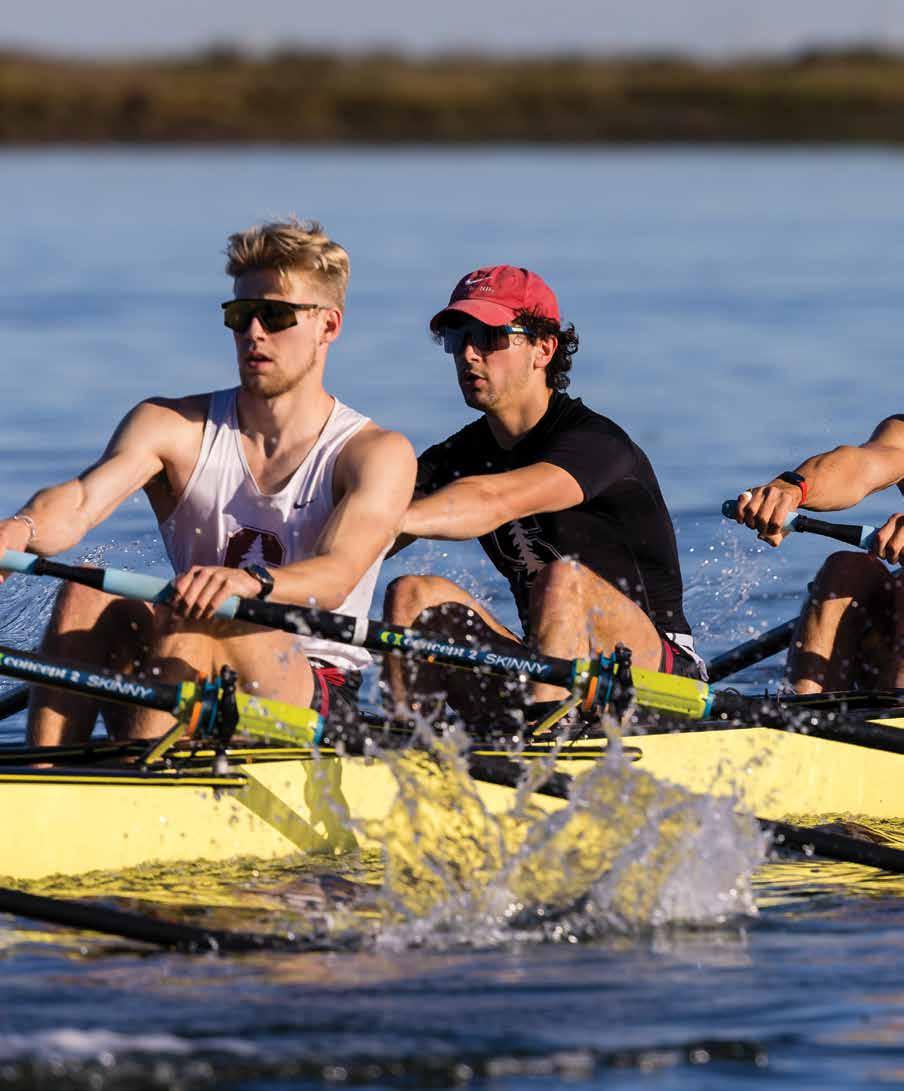
“We’re a young crew, but we don’t have to act young or race like we’re young,” says Stanford head coach Ted Sobowleski.
44 APRIL 2024
“They are very serious about making sure that anybody who is admitted as an athlete is going to contribute at a high level to the classroom environment, to the social environment, and to the world as a Stanford alum after graduation.”
— John Pojednic
understand how to to move the boat as well as they can and what their trajectory can be as an individual athlete.”
Sobolewski has formed a strong relationship with Stanford’s admissions office and is seeking more financial aid; more scholarships would be “a game changer.”
“They are very serious about making sure that anybody who is admitted as an athlete is going to contribute at a high level to the classroom environment, to the social environment, and to the world as a Stanford alum after graduation,” said Pojednic.
Which is why the Stanford coaches spend a lot of time and effort making sure the person is “an OKG—our kind of guy.”
“It’s an amazing place because you can row all the time,” Pojednic said. “We have to blend West Coast water time with East Coast attitude to make sure we’ve got the requisite training, toughness, and teambuilding.”
In the 2023 IRA petite final, the Stanford men finished second to Brown, one of only three Ivy League programs to finish ahead of the Cardinal (Princeton and Yale were third and fourth in the grand final). Although they graduated two stars in senior co-captains Henry Stewart and Flinn Traeger, who went on to race as a pair at Henley, Stanford’s varsity could be even better this year and for years to come— despite the fact that half the varsity consists of freshmen.
“We’re a young crew, but we don’t have to act young or race like we’re young,” Sobowleski said. Before the start of this year’s racing season, Sobolewski called his new crew “objectively better than 365 days ago.”
It’s a young roster because the attempted cancellation of the program robbed Stanford men’s rowing of an entire recruiting class. When Stanford announced the reinstatement of the cut rowing programs in the spring of 2021, it was too late to recruit for the Class of 2025. But a solid group of freshmen this year, including six athletes from the hyper-competitive and fast ranks of British schoolboy rowing, has created Stanford’s “most competitive twoeight environment ever,” Sobolewski said. “I believe in these guys.”
Even with plenty of promising freshmen and sophomores, Sobolewski, because of the missing class of recruits, must deal from a short deck. The opposite is true on the other end of the megaphone, however, as Stanford now features, for the first time in its men’s rowing history, a full complement of three full-time coaches, including Pojednic, and three support staff.
The replenished resources, besides making a stark difference at last year’s IRAs, augur well for the future.
“The freshman class coming next [September] is absolutely unbelievable, and we’re moving in a similar direction with the guys arriving here in the fall of ’25,” Pojednic said. “We’re looking forward to building a complete roster of recruited athletes.
“I don’t even know the last time Stanford was able to compete for team points at the Pac-12 championship or the Ten Eyck championship at the IRA because we haven’t fielded a third eight.”
For now, they struggle to boat three complete eights. “There ‘s been maybe four days this year when we’ve had three eights on the water,” Pojednic said. “We’re keeping this thing going with a four and some
pairs.”
Added Sobolewski: “It’s made for an interesting year.”
The three non-recruited juniors on the roster may be the best entirely walk-on class in the country. Two of them, Logan Morley and Noah Tan, coxed in high school and got to Stanford on their own, and the third, James Fetter, swam in high school.
“He sits down one day in the morning and pulls a 19-minute 6K and then you see a video on YouTube later in the day. He’s a trained concert pianist! Just a freaking amazing kid,” Pojednic said. “He’s worth like four guys.”
Stanford will try to race three eights at the IRA Sarasota Invitational against Washington, Harvard, Yale, Brown, and Northeastern—essentially an IRA nationalchampionship semifinal field—March 29 and 30.
“We’re throwing them right into the frying pan,” said Pojednic. “It should be some great racing. It’s the kind of trip we’d like to be able to make every year—a lot of great teams, a lot of good racing, a legitimate venue.”
“We recognize them as a competitor,” said Brown University coach Cooke. “We think they’re going to test us and we’ll be testing them and we look forward to seeing how that all goes.”
In the meantime, being young shouldn’t be a problem.
“We’ve been here before in 2019,” said Pojednic, recalling his past with Sobolewksi. “We had five freshmen in our varsity at Northeastern and finished fifth at the IRA.”
The Cardinal’s eighth-place finish at the 2023 IRA could well be just the beginning of their success on the water—after some big wins off the water.
45 APRIL 2024

46 APRIL 2024
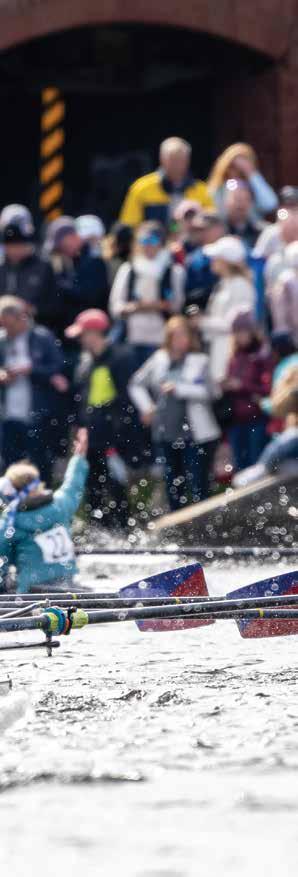
CLEAR AND PRESENT DANGERS
FROM COLLIDING TO CAPSIZING, IN FOUL WEATHER OR ROUGH WATER, THE PERILS OF AN OUTDOOR WATER SPORT LIKE ROWING ARE OBVIOUS, POTENTIALLY LETHAL—AND TOTALLY PREVENTABLE.
STORY BY Madeline Davis Tully
47 APRIL 2024
PHOTO: LISA WORTHY.
As the water swelled and began licking over the gunwales of the three coxed fours I was coaching that gray early April afternoon, I realized I was woefully underprepared to handle the situation confronting me and my 15 high-school athletes.
My coaching career began mere months after college graduation when I was named the head girls coach at a high school. With zero coaching experience, I was thrown quickly into creating a training plan, organizing an out-of-state spring-break trip, and, of course, developing my new rowers.
Like many young coaches, I had no formal education about how to do any of this, so I cobbled together my own approach based on what I had seen done previously, advice from local coaches, and what felt right. Most of the time it worked out pretty well, but not always. Not that April afternoon.
I had looked at a weather forecast but I didn’t really know what to look for. I was checking mostly for rain and temperature, not a wind forecast and certainly not a map of wind direction. I didn’t know the water temperature. So when, not long after we launched, the wind began to build, funneling down the lake and rolling into whitecaps, I was caught off guard.
The rowers grew increasingly concerned
might not have been so lucky. The lesson for me: luck should have no role in safety.
My experience, sad to say, is not unique. Many coaches and rowers are not only uneducated about matters of safety but also unaccountable. Within our teams and clubs and at our regattas, we often place perceived competitive and training “needs” ahead of clearly defined and consistently enforced safety guidelines.
“What we do is extremely rowing-first,” said Tom Rooks, Director of Safeguarding at USRowing, (see interview, page 52) “and then we splice in as much safety as we know about—what some coach told us along the way. We don’t have a professional maritime approach.”
Little wonder. Few coaches consider themselves “mariners”; they are simply coaching a sport that happens to be contested on the water.
This attitude leaves us exposed unnecessarily to the dangers of an outdoor water-based sport—hypothermia, heat stroke, collisions, capsizing, drowning. Without proper protocols, coaches, facing the pressure of conflicting priorities or ignorant of impending risks, are left to make decisions in the heat of the moment, putting rowers at risk of injury and death.
Though rare, people have died rowing.
In 2022, three rowers drowned in the U.S., and another four perished in 2021. These tragedies occur at every level, from high-school novices to elite rowers at world championships.
as I told them to turn and head back to the docks. Now broadside to the rolling waves, their shells were riding along the peaks and troughs, taking on water with each passing swell. I followed as closely as I could, though in my small tin jon boat I wasn’t faring any better.
Several coaches for other local teams, who were more experienced and had decided wisely not to go out that day, waited on the docks and pulled in each boat quickly. Everyone made it back intact, I’m glad to report, and the only injuries were my pride and a lost flip-flop. Very easily, though, we
In 2022, three rowers drowned in the U.S., and another four perished in 2021. These tragedies occur at every level, from high-school novices to elite rowers at world championships. Some are caused by medical events, while others, such as those involving equipment failure and collisions with other boaters, are terrible accidents beyond the control of rowers and coaches. Some, however, are the plain result of poor judgment and ignorance. They could have been avoided, and therefore are inexcusable.
In 2022, two boys, Langston Rodriguez-Sane, 12, and Gavin Christman,
13, died after their shell was struck by lightning and capsized. According to a wrongful-death suit filed by Rodrigez-Sane’s family, it was the boys’ first day on the water with the North Orlando Rowing Club. The club had “no effective weather-detection or alert system operational” that day and “failed to adequately and timely alert the rowers of the inclement weather and ensure they returned safely back to the boathouse.”
Moreover, an on-site automated external defibrillator (AED), which was used unsuccessfully on Rodriguez-Sane, was not working, the suit claimed.
“There’s no good reason why these kids were sent out when they were, the way they were, on the day they were,” said Andy Yaffa, the family’s attorney. “Had any of the most basic precautions been taken, neither of these two young men would have died.”
Basic precautions were ignored also on Iowa’s Little Wall Lake in March 2021 when two Iowa State rowers, Yaakov Ben-David and Derek Nanni, drowned after their coxed four capsized. According to an independent review conducted by the U.S. Council for Athletes’ Health, several safety guidelines were disregarded or not in place. No safety launch or coach was present. Although the club’s constitution bans rowing when winds exceed 14 m.p.h., winds were blowing between 20 and 25 m.p.h. at the time of the incident, and the water temperature was 40 degrees. Furthermore, team leaders failed to ensure that proper safety equipment and communication devices were available.
In 1984, Kippy Liddle, a coach from the Brooks School in Massachusetts, was overseeing her high-school athletes as they trained during spring break on the Schuylkill in Philadelphia when her launch engine died. She and a high-school student on board were swept toward the Fairmount Dam and grabbed ropes strung across the river. After ensuring the safety of the young coxswain on board, Liddle abandoned the boat and attempted to swim for shore. She drowned after being swept over the falls.
In 1983, at the University of New Hampshire, alumni were in town for a fundraiser and class-day row for the men’s and women’s club teams. Despite two Coast Guard small-craft warnings, five eights ventured out in the treacherous weather. Multiple boats swamped, and when one of the shells capsized, 19-year-old Glenn Hayes attempted to swim to shore. He succumbed to the icy water and drowned, and 11 other
48 APRIL 2024
The Tragic Case of Dzmitry Ryshkevich
World Rowing’s Matt Smith tells the inside story of the brave Para rower who drowned at the 2019 World Championships.
“Many events have been staged safely in Austria at LinzOttensheim, the site of the 2019 World Rowing Championships, and the safety team for the course was very experienced. Before the event that year, significant work had been undertaken, including building a new boathouse and enlarging the boat park area, which featured a dedicated Para rowing area and pontoon.
Because of limited water space for racing and training, traffic patterns were discussed and tested extensively. In 2019, a training area was created for Para singles because often they had little time to prepare, since they tend to be the slowest boats in the regatta.
Safety during training and racing was taken extremely seriously by the organizing committee and World Rowing. Although regatta safety is the legal responsibility of the organizing committee, it is carefully elaborated with the many years of experience of World Rowing’s events team. This includes such matters as the number of safety boats and professional patrolling during training and racing.
Now to the tragic case of Dzmitry Ryshkevich. His was an amazing survival story. In 2003, when he was 17, he was run over by a car in his hometown of Grodno, Belarus. Many of his vertebrae were crushed, many of his body organs were damaged or had to be removed, and he hit his head hard and suffered brain damage. The fact that he survived was miraculous enough, but then he required numerous surgeries, and his recovery called on the total support of his family and friends. He showed great courage
to switch to Para rowing, which he began in 2007 after competing in other Para sports. In Beijing in 2008, the first Paralympic Games to feature Para rowing, he won a silver medal.
In 2019, Dzmitry went on his first training row on the opening day of training at Linz-Ottenheim. When he reached the end of the training lane for Para singles and began to turn his boat around, his upper body swayed to one side, which caused the rigger to break off the starboard side (there was no damage on the port side because the nuts and screws were missing).
The boat capsized, he went under, and, unable to right himself, sank. His very developed upper body and high center of gravity made it difficult for him to maneuver in the water. Safety motorboats rushed to the scene in accordance with protocol, and divers began searching.
Since the regatta course had been dredged recently to return its depth to three meters, the water was cloudy, and it was difficult to see the farther down the divers went. In addition, the water level of the Danube changed each night because of a hydroelectric dam at the 1,000-meter mark, which stirred the bottom sediment. Scuba divers summoned to the accident site from all over the area continued hunting for hours, but it was too late to save Dzmitry. It was a tragic experience that underscored the critical role and responsibility of coaches and support staff in Para rowing.
So far, there has been no public disclosure of the conclusions of the accident investigation since it’s considered a private matter
between Austrian authorities and the Ryshkevich family.
In corresponding with Dzmitry’s father at the end of the inquiry, however, I learned that the police report stated that after off-loading Dzmitry’s boat in Linz and setting it up for training, his coach neglected to install the screws on the port side of the wing riggers. Although the coach was indicted for negligence in Austria, he has avoided prosecution so far by staying in Belarus since the accident. The organizing committee and World Rowing were not cited in the inquiry for any negligence or lack of due diligence.
A full review of safety at World Rowing events by an independent water-safety advisory firm based in the UK had been planned since 2017. The review was approved in 2019, but its start was delayed because of Covid event cancellations in 2020. In October 2021, a report covering five areas and recommending 34 actions was delivered to World Rowing for consideration. No significant errors or omissions in safety protocols were identified, but things such as better systems, more documentation, and appointing an overall safety officer were highlighted.
The recommendations were then reviewed by the various World Rowing commissions that are involved in safety, regatta organization, and equipment. Recommendations specific to Para rowing were passed to the Para Rowing Commission, and I believe most of them were adopted during 2022.”
49 APRIL 2024
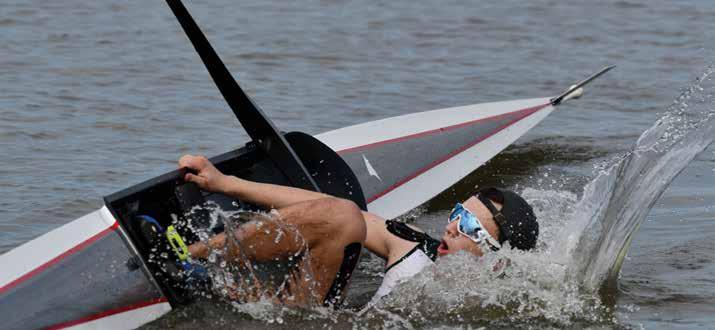
Never Swim to Shore, and Other Safety Rules
• Stay with the boat: Should any boat swamp or capsize, all rowers and coxswains should stay with the boat and never swim to shore for help. This is the single most important safety advice, and this, alone, can save lives.
• Safety committee: Every rowing organization should have a safety person or committee responsible for establishing and enforcing safety guidelines specific to the team and location. All members of the club should be familiar with these. Create emergency plans and a site map indicating all bridges, traffic patterns, and rescue access points.
• Weather checks: All coaches should perform a comprehensive weather check before launching, including air and water temperature, wind, water flow rate, fog, strong current locations, debris, looming thunderstorms, and any other relevant local factors. If it’s iffy, do not row.
•Go no-go matrix: Everyone should have the authority to determine safety. Everyone from the assistant coach to the president of the club ought to be authorized to make a safety determination.
• Bow and stern lights: All boats going out at dusk, dawn, or in low visibility should have lights on both the bow and stern. If you’re not sure if it will be dark enough to need them, err on the side of putting them on.
• Life jackets: Consider inflatable life jackets for rowers, coxswains, and coaches, especially in very cold conditions and for less experienced rowers. Life jackets should always be worn by anyone who hasn’t passed a swim test, and all launches should be equipped with enough easily accessible life jackets to rescue at least the largest boat you coach.
• Check hardware: Get rowers and coxswains in the habit of
checking all hardware on their seat before each row. They need only to finger-tighten everything to identify any major issues.t
• Log book: A log book always should be used when boats are going out without a coach, which should be limited to experienced rowers and good-weather conditions. All crews should log in and out, with a dedicated club member responsible for keeping regular tabs on the log and following up immediately with any discrepancies.
• Audit: Complete the USRowing Safety Audit Checklist. Have all athletes watch the USRowing safety video every year.
•When in doubt, everyone in a position of responsibility should ask themselves: How will I defend this decision to the families of the people involved, or in court?
50 APRIL 2024
PHOTO: USROWING.
rowers were hospitalized for hypothermia.
At the 2019 World Rowing Championships, Dzmitry Ryshkevich, an experienced Para rower competing for Belarus in the PR1 men’s single, drowned after his shell capsized during a training row. As he spun at the end of the warm-up lane, his rigger broke off, the shell rolled, and Ryshkevich went under.
Other competitors and regatta staff witnessed his submersion, and although safety motorboats and divers responded quickly, Ryshkevich could not be located in the murky water. An investigation later revealed that Ryshkevich’s coach “neglected to install the screws on the port side of the wing riggers,” said Matt Smith, World Rowing’s executive director at the time.
When faced with such loss, the rowing community either learns and adapts or risks further loss—of life, of the sport itself.
“There has to be a reason for our suffering,” Rooks said. “For me, it’s so we can learn to make others better, to improve our next experience.”
Improvements have occurred.
“Every safety guideline is due to the suffering or the loss of someone else,” said Rooks.
In the aftermath of the loss of Rodriguez-Sane and Christman, the Florida Scholastic Rowing Association partnered with a local meteorologist to help coaches understand lightning risks. Iowa State conducted a review of club sports and instituted strict safety requirements for all teams. “Kippy Kits,” safety-gear bags containing life vests, a paddle, throw lines, and more, became commonplace in coach launches. At UNH, budgets for the club teams were increased to provide more coaching supervision and safety equipment, including better launches with life jackets on board.
The challenge is ensuring that these changes last. Commonly, as time passes, the people affected by the tragedies move away, the stories are forgotten, and apathy sets in. Safety requirements are eased. Budgets for safety equipment trimmed. As a high-school rower on Boathouse Row fewer than 20 years after Liddle’s death, I rowed past the Fairmount Dam every day but never heard her name or story.
“We, as a sport, refuse to learn,” said Jeff Friedrichs, a UNH crew-club alum
and founding member of the Foundation for Rowing Education. “We have a history of machismo, of keeping our heads in the sand.”
Had the lessons of the UNH incident been shared widely, perhaps lives could have been saved at Iowa State and North Orlando.
“It starts with accurate reporting,” Rooks said. “What we have now is if somebody’s harmed in your region, or in your area of rowing, you know about it. And then about eight years later, we’ve moved on.”
Several rowing organizations recognize the importance of safety exceptionally well and back up their words with deeds.
The website of the Three Rivers Rowing Association declares: “Safety is the number-one priority.” The site presents relevant weather information, including air and water temperature, wind speed and direction, and water flow, as well as the Pittsburgh-based club’s safety procedures.
“These documents are reviewed annually and updated with the latest information and best practices,” said executive director Matt Logue. “We have a very engaged safety committee.”
The University of Washington is proud, rightfully, of its Water Emergency Training program (WET), which was developed in 2016 by the UW rowing teams, local police, fire, and medical personnel, and team physician Henry Pelto.
At the time, UW medical staff had procedures in place for responding to emergencies at every kind of sporting event and location, including the boathouse, but nothing for a medical emergency on the water. The team devised procedures and training for how to remove athletes from shells, move them into the coaching launch, and administer first aid. Each launch at UW is equipped with an AED.
WET aims to promote the safety of rowers around the world by creating emergency-action plans that fit the unique needs of each club, team or university. Its website offers videos demonstrating how to administer chest compression in a rowing shell, how to remove an incapacitated athlete from a shell using a chest strap, and more.
Both Washington and Three Rivers prove that a commitment to safety needn’t
come at the expense of competitive excellence. The Three Rivers juniors won four regional championships, sent eight crews to Youth Nationals, and brought home a silver in U17 women’s single last year. The UW men and women both finished second at their respective national championships in 2023.
At the national governing body, Rooks is working to improve education and communication. USRowing issues an annual safety report, and Rooks and his team are working on a more comprehensive safety manual with clearer, more concise guidelines.
In addition to Rooks, who is, as far as he knows, the first full-time staff member dedicated entirely to safety, USRowing recently hired an internal case manager for the first time. Emily Goldsmith handles all safeguarding complaints, from physical injuries to SafeSport violations.
Beyond the obvious threat to life and limb, lax attention to safety threatens our sport’s very existence. Schools, clubs, and boards of directors won’t support an activity that may maim or kill participants, especially young ones. After the Iowa State investigation into club sports, the university instituted strict guidelines that resulted in the discontinuation of several teams, including sailing, water skiing, canoeing and kayaking, and skiing and snowboarding because of a “prohibitive level of risk.”
Safety is everyone’s responsibility. Rowers should be aware enough to listen for thunder themselves. Coxswains should ensure that all shells have lights when rowing at dawn or dusk. An assistant coach should be able to tell the head coach that the team cannot launch if visibility is too low.
If that’s not happening on your own team, changes need to be made. Now. Lives depend on it.
51 APRIL 2024
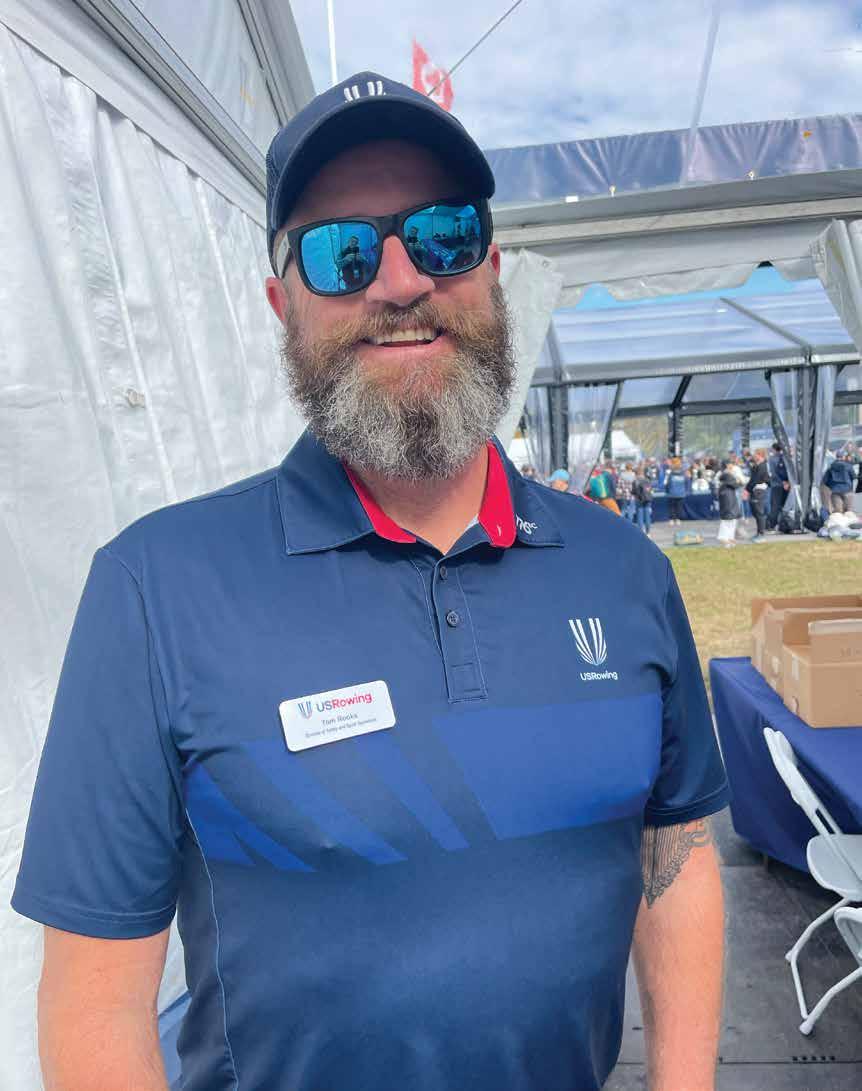
52 APRIL 2024
THE INTERVIEW:
TOM ROOKS
USROWING’S DIRECTOR OF SAFEGUARDING LIKES HIS JOB BECAUSE DOING THE RIGHT THING MORALLY AND ETHICALLY IS ESSENTIAL TO THE VERY SURVIVAL OF ROWING.
53 APRIL 2024
United States Coast Guard veteran Tom Rooks, a longtime rowing coach, now serves the sport of rowing full time with USRowing, overseeing a new, invigorated approach to safety. Rowing News caught up with Rooks at the end of an early-season junior-rowing practice.
Rowing News: What’s your new job?
My job is Director of Safeguarding, which puts a few things under my team’s tent. I still have the priorities with safety that I did prior to this position. I’m responsible for getting safety communication and education out there, and looking at ways to reduce harm from a physical-safety perspective.
But what’s changed is that SafeSport, grievance procedures, and the Referee Corps, those things are now with our team. And that all came with the development of the vision toward safeguarding. The easy way to explain it is: Let’s reduce harm. Sometimes that’s physical, sometimes it’s mental.
If that’s a kid who hates the sport or is unable to stand up straight, if that’s from hazing on a high-school team, or if that’s from not listening to your body and seeing a doctor, the harm is the same. So what we’re trying to go after is: “Where are there places
Rowing News: Before you came to USRowing, you served in the United States Coast Guard. Tell us about that.
Yes, I’m a 22-year active-duty veteran. I’m a retired Senior Chief, and ironically enough, my last job in the Coast Guard was running the school for all of our coxswains. So anyone who wanted to become a Boatswain’s Mate—the trade of driving boats on rescues and law-enforcement missions—they had to get through our schoolhouse.
I got involved with USRowing [laughing ], I blame Chris Chase for my job at USRowing. He called me one day because we were friends and said, “Can you help out with safety?” And I said, “Sure.” Chris Chase gets you motivated, and the next thing you know you find yourself contributing.
Rowing News: SafeSport certainly has some limitations, as we found out the hard way with some coaches who were in the news. USRowing had its hands tied with how much could be done. Where does safeguarding go beyond that?
So the beauty of safeguarding is we can look for where there are overlaps and where there are gaps and we can fill them.
“Where are there places where we can reduce harm while still letting rowing deliver all the great lessons and experiences that it has to offer?”
where we can reduce harm while still letting rowing deliver all the great lessons and experiences that it has to offer?”
Before I became the Director of Safeguarding, I was the Safety and WellBeing Associate. And then I was the Director of Sport Safety, which was kind of the same role with a bit of a promotion. And then what really happened was the more you look into the incidents we have in our sport—be it drownings, collisions, abuse, all those things—a lot of the harm comes from the same lack of curiosity about how to evaluate risk and do the right things to reduce it.
—Tom Rooks
A good example is if you were at a regatta and your coach refused to let you wear a jacket and the regatta was two hours behind and 40 degrees with the wind blowing 20 miles an hour. If you think about it, we have a SafeSport incident, right? We also have a non-contact physical misconduct, but you also have a safety incident. You also possibly have a referee complaint and you might have disagreements on your hands. By unifying all these processes and concerns under safeguarding, we can take a look at a given scenario and find out what best applies to mitigate it and better find all of the lessons learned.
I’m a firm believer that, outside of a character-driven mistake, a lot of people make mistakes we should learn from and help them learn from. I made a lot of mistakes as a young coach. And one of the things with that is finding where there are avenues and outlets where we can learn and spread the lessons learned, so the next person doesn’t have to make the same mistake.
There are a lot of people who have experienced something that they shouldn’t have, and they don’t know what to do with it. We can’t expect a 15-year-old rower to know what should be a local club problem to resolve and what should be reported to SafeSport. So there are two aspects for me to safeguarding: prevention and response. We have a partnership with WeRideTogether, and they have a really good education module up on The Launch [USRowing’s online-learning platform] right now that people can take for free. It teaches them what is a healthy relationship with your coach and what is unhealthy. We’re trying to find more tools, especially on the prevention side. With response, we have SafeSport requirements we follow and we don’t have the option to say “no, thanks,” and do things our own way. There are certain cases that are mandatory to go to them, and their processes are rightfully very defined. But on the prevention side, having the safeguarding concept in place really gives us a lot of freedom to do better education, like our annual safety report. If somebody reads that and sees that last year we had a lot of regatta incidents with uncoxed boats hitting each other, then maybe they say, “Let’s put it in a training plan for whomever is going to steer a quad or double.” And maybe that prevents the next person from getting run over out there or having their boat destroyed.
Rowing News: We’ve been talking about the human costs of safety issues, but there’s also a financial cost, right?
I was pretty proud of how open we were about the insurance problems we faced last year. The original quotes we got from carriers were just an astronomical price increase from where we had been just a year before. And the really direct truth of it is what we call SAM coverage, sexual assault and molestation. A lot of carriers are pulling out of the U.S. market because with the amount of revelation of what’s
54 APRIL 2024
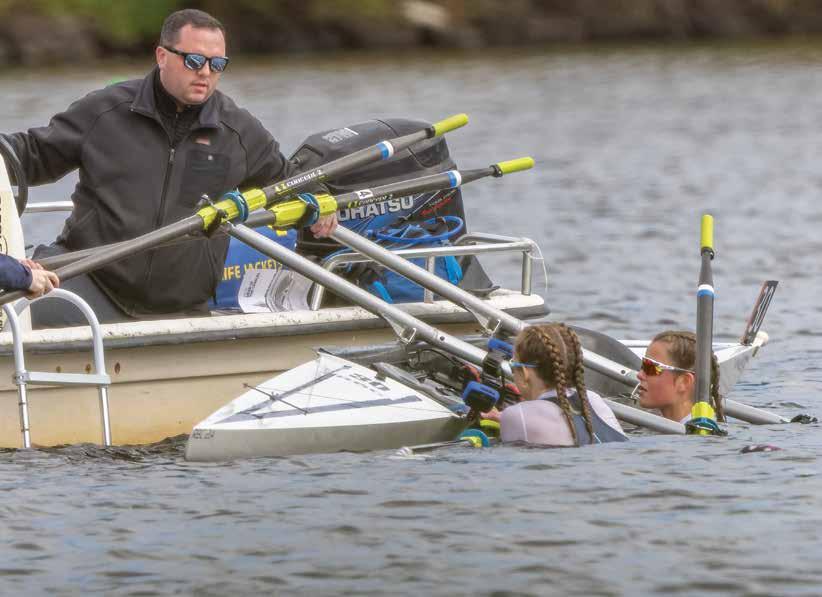
happening in youth sports and what has happened over the years, it’s getting pretty hard for insurance providers to feel like they have any understanding of what next year may hold.
The thing I like about my job is, it’s the right thing to do morally and ethically to reduce harm, but it’s also the survival of our sport. If things keep going—and it’s not just rowing, it’s across sports—but if things keep going this direction, if you don’t find a way to reduce bullying, abuse, molestation, all these things that are happening, if we don’t fight this like it’s an existential threat, it’s going to change the rowing landscape.
So many people have done so much good work in the 30 years I’ve
been involved at opening up our sport to community programs, getting out of just the private, well-funded schools and into more places people can row. If our insurance costs start doubling every year, those are the programs that go away. Your local rowing club, that’s who will go away if we can’t get our heads around this to start reducing harm in the sport.
Rowing News: What’s your vision? What will you look back at and say, “That’s where I really moved the needle? ”
When a tragedy happens in our sport, I want to be surprised. Right now, throughout our sport’s history, when things have happened, I find myself and a lot of
people I know going, “Well, it was only a matter of time.” I want to be surprised. When I was in the Coast Guard, I lost shipmates. I lost friends. The goal was when we read about the mishap that we couldn’t have imagined it would have happened.
So for me, however long I’m able to endure, however long this career goes, when I walk away, I want to have a professional culture that looks at risk. I talk a lot about this concept: I’m pro-risk. I’m anti-chance. Risk, we can look at. We can calculate. We can mitigate it. Chance is when we see the risk and go, “Well, hopefully, it’s OK.”
We owe each other more than that.
PHOTO: LISA WORTHY.
55 APRIL 2024
Have a launch equipped to help rowers when things go wrong.


Downing the Resistance
From my own experience as a coach and athlete, I’ve noticed time and again that splits get better as the temperature rises. The differences are by no means tiny.
As winter turns into spring and summer, we rowers experience pleasant changes. Not only can we reduce our intake of vitamin D supplements, as our bodies produce this vital nutrient through exposure to sunlight, but also our boats glide through the water faster as if by magic, without our having to put in any extra effort.
This is not only because we reduce the weight we carry in the boat by getting rid of the layers of clothing we needed in cold weather but also because higher temperatures reduce the resistance forces that slow us down.
From my own experience as a coach and athlete, I’ve noticed time and again that splits get better as the temperature rises. The differences are by no means tiny. You row at your steady-state pace and a
week later you’re moving with the same effort but you can see on your SpeedCoach that your splits are faster. Since this can’t be attributed to any significant change in training, it must be related to warmer temperatures.
Only a few studies exist that measure speed changes at different temperatures. When the temperature increases from 62 to 82 degrees F., the famous boatbuilder Klaus Filter showed a speed improvement of 0.66 percent, and Jacques Bex calculated an advantage of 0.97 percent. Training at the higher temperatures, a crew rowing 500 meters in 2:10 would cover the same distance in 2:09.1 or 2:08.8, respectively. While the differences are small, a crew certainly would notice.
How can this be explained? Every
liquid exerts drag forces when an object moves through to it. Because an object has to push the liquid molecules aside in order to move forward, the less densely packed the molecules, the easier it is. This is what happens as the temperature rises. Since each molecule takes up more space without changing its mass, the density of the liquid decreases. Result: an object moving in warmer liquid encounters fewer molecules and experiences less resistance.
Density is one of the factors in the formula used to calculate the drag force of an object moving through to a fluid. Assuming that such other factors as drag coefficient, cross-sectional area, and object speed remain constant, the resistance encountered by an object as it moves through a liquid or gas changes linearly
TRAINING
PHOTO: LISA WORTHY.
Fast boats go even faster in warm water: the bronze medal-winning 2023 U.S. women’s U23 coxed four in Plovdiv.
SPORT SCIENCE | TRAINING | COXING | BEST PRACTICES | FUEL | COACH DEVELOPMENT
57 APRIL 2024
SPORT SCIENCE
TRAINING
COXING with the temperature of the liquid. For our sport, this means that the drag forces decrease at the same rate as the density as the temperature increases.
For a long time, I considered only water resistance as a variable that decreases at warmer temperatures. On closer inspection, however, I found that the change in water density is so small that we see hardly any difference in speed. For example, the density of the water changes only by 0.2 percent from 62 to 82 degrees F., which means that the crew mentioned above would experience a meager speed uptick of 0.3 of a second over 500 meters, which would be undetectable with a SpeedCoach.
While there’s no doubt that we experience discernible increases in speed as the water gets warmer, the density changes of water cannot be the sole reason. This is especially true when we consider that as density decreases, our boats sink a little deeper in the water to achieve the buoyancy needed to keep us afloat. This, in turn, increases the wetted surface area of the hull and affects drag.
Another reason for the increase in speed as temperatures rise is the air resistance of the rowers, boat, and oars. The drag forces that slow us down are generated by water and air, and air drag in rowing is significant, ranging from 20 to 40 percent. Our bodies, the boat with its riggers, and, above all, the oar shafts and blades form a relatively large surface area. Temperature changes the density of air more than it does water—by 3.4 percent from 62 to 82 degrees F.
If we factor in the change in air density, we can see why speed increases noticeably when we row in warmer weather. If air resistance accounts for 20 percent of the total when rowing, we get the figures given by Filter and Bex. If air resistance accounts for 40 percent, there’s an additional improvement of 0.6 of a second for the crew in the example above.
The Vital Skill of Backing Into Stake Boats
Often, the limiting factor in developing coxswains is coaches and their lack of interest in teaching coxswains what they need to succeed.
This article is for coaches, and I say that knowing right off the bat that the ones who need to read it most won’t.
Often, the limiting factor in developing coxswains is coaches and their lack of interest in teaching the skills coxswains need to succeed. So consider this a quick hit of professional development, prefaced by my usual reminder that the rowers are not the only athletes on your team worthy of your attention and guidance.
At some point this season, your coxswains are going to have to back into a stake boat, and like most things related to coxing, it both is and isn’t as hard as it seems. Once you’ve done it a couple of times, you can do it with your eyes closed the rest of your career. That said, it takes deliberate thought and maybe some diagramming on the part of coxswains, patience and engagement on the part of the crew, and a dedicated allocation of practice time on the part of you, the coach.
Notice that I didn’t say reallocation. Among the bare minimum coxswains should expect from you, allocating time during practice well in advance of the team’s first race to rehearse backing into stake boats ranks high.
before he can leave the floor,” the article stated.
That’s why Curry leads the league in free-throw percentage. He’s made the physical and mental practice a built-in, unquestioned part of his day-to-day routine, as regular as the rising and setting of the sun.
We’ve all experienced good stress and bad stress on race day, but when bad stress stems from knowing you’re unprepared to back into a stake boat, your coxswain and the crew are already at a mental disadvantage. It’s overwhelming, it’s distracting, and there’s nothing more cherry-on-top than having eight people display the Dunning-Kruger effect by telling you confidently what they think you should do.
Coaches, don’t set your coxswains up for failure by not making time to practice the physical and mental skills they need to be able to do this successfully. You have full control over the 90 to 120 minutes of practice time each day. “There isn’t time” is an excuse that says to your coxswains that you don’t value them or their roles enough to help them learn how to execute a fundamental aspect of race day.
So temperature does indeed influence rowing speed and therefore race times. And because air is such a big part of overall drag, streamlined features such as riggers, skinny shafts, and close-fitting clothing are of tangible value when it comes to gaining an advantage in a race.
Backing into stake boats is the equivalent of shooting free throws in basketball. Steph Curry doesn’t have a 91-percent free-throw average because he just shows up on game day and wings it. A few years ago, an article in The San Francisco Chronicle described how on game day Curry blocks out everything around him before he takes a shot and allows muscle memory to guide the ball through the hoop. If he misses, it’s because he thinks, if only for a split second.
VOLKER NOLTE
“When physically and mentally fatigued at the end of each practice or workout, he must hit 10 foul shots—at least five of which have to be swishes—
As much as I believe coxswains should advocate for themselves, I also realize that’s hard to do, especially for younger or newer coxswains. Rather than waiting for them to ask, “Can we practice this?” make it a default part of the plan each day. You’ll never convince me that spending 10, 20, or 30 extra minutes on drills or steady state is a more valuable use of your time.
Below are the basic steps I talk through with coxswains on land before they practice on water. Having a whiteboard helps, particularly with visual learners, so we can diagram where the boat needs to go and who needs to do what with each oar. This is from the perspective of coxing a port-rigged eight in reasonably calm conditions. Obviously,
58 APRIL 2024
further adjustments would need to be made in adverse conditions, which is why you need to practice in good weather, bad weather, during a good practice, after a bad practice, etc., so you can account for whatever elements you might encounter on race day.
Step 1: Pull into the center of your lane, no more than a length of open water in front of the stake boat. If you have time to take a couple of 10s before you need to get locked on, turn around and row back to the start rather than backing it down for 400 meters. Sometimes you can do this in your lane; other times you need to exit the course completely. Confirm at the coaches and coxswains meeting which is applicable for your venue.
Step 2a: Confirm the shell is aligned with the stake boat before you begin backing. There are too many variables at play to try to be dead-on straight before you begin backing it, but you do need to be reasonably well centered and aligned. This will save you a lot of time and effort later.
Step 2b: Ensure the rudder is straight and remind the rowers to keep the boat set and not to fidget in their seats while you’re backing it down. Sometimes those who aren’t rowing will stretch, take off an article of clothing, reach down to grab a water bottle, turn around to talk to whomever’s behind them, and all that contributes to the boat’s being offset and pulling to one side or the other. The rudder is more likely to get pulled around as you back it, also causing the boat to turn to one side, so you’ll need to keep the cables taught to prevent this.
Step 2c: Back it down with your stern four, not bow four. The stern of the boat is the part you’re trying to maneuver, and having your stern four backing will give you maximum control over that end. In my experience, the power range that works best is arms-only at half pressure (minimum) up to arms-and-bodies at three-quarter pressure (maximum). I never include the legs and never use full pressure.
The number of people you have rowing and at what pressure should also be proportional to the distance you are from the stake boat. Don’t back it down from two lengths away with just your
stern pair rowing at half pressure, and don’t back it down from half a length away with your stern six going full pressure. Common sense is critical throughout this whole process, but especially here.
Step 2d: While the crew is backing, your upper body should be turned so you can see over your shoulder. You also need to keep your weight centered so the boat doesn’t pull to one side. If I haven’t already connected with the stake-boat holder, this is when I try to lock eyes and say, “Hey, what’s up.” That assures me the holder is paying attention and ready to catch the stern.
Step 3: Clearly, assertively, and at an appropriate volume, communicate to the crew when they need to weigh enough. You can usually stop backing when your stern is three to four seats away from the stake boat. You’re going for a gentle drift, not a Tokyo drift. As you get closer, the stake-boat holder will grab you and you’ll officially be “locked on.” If the stake-boat holder can’t grab you because you’re too far to one side, you’ll need to pull forward and try again. It’s rarely worth the time and effort for the holder try to hold on to the boat while you readjust. Just have the holder release the stern and try again.
Step 4: Once the stake-boat holder has a firm hold on the stern, get your point. Full disclosure: This is the hard part that’s not actually hard if you’ve had adequate time to prepare and practice. It requires clear communication on your part and diligent coordination on the rowers’ part.
Since the stern needs to remain stationary, you’ll want to move the bow laterally by having the rowers take very small, precise strokes—what we call “sculling it around.” This is more efficient than having bow or two seat take normal strokes, since that will pull you forward and out of the grasp of the stake-boat holder, whereas sculling gives you more lateral control and less forward pull.
Sculling it to port: In a port-rigged shell, to get your bow pointed to port, have your two seat hold the oar in the right hand, reach around with the left hand to grab bow seat’s oar, tap down and feather it out of the water, and bring it parallel to the boat. Once parallel, the rower can take short arms-length strokes, keeping
the blade on the square the entire time. Usually, three to five are all you need if you’re relatively straight and there isn’t too much wind.
Sculling it to starboard: In a portrigged shell, to get your bow pointed to starboard, have your three seat hold the oar in the left hand, reach around with the right hand to grab two seat’s oar, tap down and feather it out of the water, and bring it parallel to the boat. Similarly as before, you should need only a couple of strokes to get your bow pointed straight.
Step 5: Locked on and locked in. You don’t want to get locked on so early that you have to spend forever getting and correcting your point. You also don’t want to get there so late that you don’t have time to get a good point at all. Timing and presence are everything.
Once I’m locked on and have my point, I close my eyes for a second, take a long, deep breath, compartmentalize, and lock in. The crew should be sitting easy and keeping the boat set while you wait for the official to say “sit ready.” Within the two-minute warning, I try not to make any additional adjustments to my point unless conditions necessitate.
Navigating a stake boat isn’t something you can learn by reading or talking; you have to perform the exercise on the water, go through the calls, and ensure that everybody in the boat knows their part. Although the coxswain is the one executing the maneuver, it’s everyone’s responsibility to ensure that it happens smoothly and efficiently.
Only one person can facilitate that, and that’s the coach. If you’re a coach reading this, I encourage you to share this with other coaches in the spirit of coaching education. Coxswains, if your coach is someone who needs this but would never read it without prodding, leave the magazine on your coach’s desk or launch before practice—opened to this page.
KAYLEIGH DURM
59 APRIL 2024
TRAINING
You Be the Judge
Deprive athletes of opportunities to decide for themselves and they learn to decide nothing for themselves.
In rowing, unlike in game sports, we coaches contribute nothing during the actual competition. Substitutions, timeouts, play-calling—rowers are not pawns in a game played by opposing coaches. Rowing coaches can’t even shout useful encouragement, since rowers are too far away usually to hear. Once they shove from the dock to race, it’s all up to our athletes. Consequently, it’s up to us to prepare our rowers to make their own decisions on the water. Initiative and judgment must be learned.
By recognizing and creating decisionmaking opportunities, we help our athletes learn to make their own decisions. These choices may be small and seemingly inconsequential, but they shift the focus from us to the athletes, which results in increased ownership. Rowers become more invested, because when it’s their decision rather than one made by an authority figure, they’re more inclined to take responsibility for the outcome. If you want to see better results on an erg test, let them pick the day and time. Choosing the path rather than merely following instructions increases engagement and motivation.
The more frequently athletes make decisions, the more comfortable they become taking the initiative. Deprive them of opportunities to decide for themselves and they learn to decide nothing for themselves. The added beauty is that with more decisions made, more experience is acquired, judgment improves, and your athletes make better choices. Problem-solving is a skill that’s developed like any other—with practice. Rowers learn by doing; in this case, the “doing” is deciding for themselves.
When giving athletes opportunities to make decisions, start small with a situation where there’s no truly bad option. Frame the decision as a choice between two alternatives (“Should we do this or that today?”). As they grow more accustomed to choosing, they’ll be better able to select the optimal course of action when the options are less defined and more numerous (“What should we do
today?”).
An incremental approach builds confidence, self-reliance, autonomy, and critical-thinking skills. All the while, you must show a tolerance for failure. If you intervene constantly, your athletes will never feel empowered, nor will they learn. To prevent major failure, maintain appropriate guardrails so your rowers can’t deviate too far from what you think is best or necessary.
Ideally, you should debrief your athletes after any big decision. “How ready to race were you after doing the warm-up you selected?” The consequences may seem evident, but don’t assume young athletes
The more frequently athletes make decisions, the more comfortable they become taking the initiative.
perceive them. They can learn best from regrettable choices when guided to do so.
Obviously, not all decisions should be left up to athletes. Often, they can’t see the big picture coaches must see, and even the most mature and experienced rowers often want to be told what to do in stressful situations. When making a decision that impacts your athletes, educate them by explaining why you did what you did.
Explaining the factors and reasons that went into the decision enables your rowers to learn from your experience and not just their own. In the words of TrueSport, an educational website dedicated to changing the culture of youth sports: “Teaching them how to decide is more valuable than teaching them what to decide.”
One of the best gifts you can give your athletes is teaching them not to need you so much.
BILL MANNING

Eating to Win
What and when you eat matters and can propel competitive rowers to the podium.
I’m wanting to row the best I can at the Head of the Charles.
Any nutrition tips to help me reach my goal?
How do Patrick Mahomes and Tom Brady eat to perform at such high levels?
I once heard someone say the best athletes have the junkiest diets. Is that true?
These are just some of the questions I get from athletes who want to eat to win. My answer: What and when you eat matters. While many very good athletes seem to do well with random fueling plans, the question arises: How much better could they be?
While wise fueling plans certainly can enhance athletic performance, many other factors determine whether or not you will get to the podium. Physiological factors
BEST PRACTICES
FUEL
60 APRIL 2024
include muscle damage/soreness, lactic-acid buildup, depleted muscle glycogen, low blood glucose, inability to concentrate/poor brain function, under-hydration, high body temperature, gut distress, and injury. Now add the environmental factors you can’t control: heat, humidity, wind, floods, and altitude, as well as the regatta’s start time, time between events, jet lag, and travel fatigue. No wonder eager-to-win rowers want to rule out making any food mistakes.
So here are nutrition strategies you can control to benefit your performance.
• Whole-grain breads, pasta, sweet potato, quinoa and other starchy carbs— plus fruits and veggies—should be the foundation of each and every meal. Stop thinking carbs are bad, fattening, a waste of calories. False! The body prefers carbs to replenish muscle-glycogen stores that get depleted during hard exercise. Training or competing with “dead muscles” hurts performance.
• All athletes need a well-fueled brain. If you haven’t eaten a meal three to four hours before exercise, at least eat about 200 calories of carbs within an hour before you row to keep your brain sharp so you can focus and stay motivated to work at a hard pace. For a personalized fueling plan that maintains your blood sugar (and feeds the brain), consult with a registered dietitian and board-certified specialist in sports dietetics. (To find one locally, visit the referral networks at eatright.org or healthprofs.com.
• Implement your fueling plan during training so you have time to tweak it. During a regatta, you don’t want to be guessing whether a new gel will digest well.
• Commercial sports foods (sports drinks, gels, chomps, jelly beans, etc.) are pre-wrapped and convenient but not magical. “Real foods” (dried pineapple, crystalized ginger, peppermints, granola bars, diluted grape juice) also work just as well, if not better, before and during extended training sessions.
• During extended training that lasts longer than 60 to 90 minutes, plan to consume a variety of sport foods and fluids. Each type uses different gut transporters and can reduce the risk of GI distress. A variety of tastes also minimizes flavor fatigue (when you can’t tolerate one more sip of Gatorade). You can compete at your best only if you can train at your best. That
means fueling well every day.
• Learn in advance what foods and fluids will be available at the event. (Check website and sponsors.) You’ll be better off bringing plenty of tried-and-true foods that you know will settle well and be available readily—and make sure to bring enough to share!
• Maintain adequate hydration during repeated days of hard training. Your goal is to void a significant volume of lightcolored urine first thing in the morning. That indicates you’re beginning the day adequately hydrated.
• Whether programmed drinking (according to a plan) is preferable to drinking to thirst (as desired) depends somewhat on the sport. Endurance rowers can develop a big mismatch between sweat losses and fluid intake, so programmed drinking can be a good plan for them. Rowers who exercise for a shorter time are less likely to become dehydrated, so drinking to thirst is acceptable.
• In laboratory-based research, a loss of body weight of more than three percent is linked to reduced performance. In real life, many athletes perform well at higher levels of dehydration. Their motivation to win overrides the effects of being under-hydrated and lessens its negative impact. But the question remains unanswered: Could underhydrated athletes have performed even better if they were better hydrated?
• If you think a sports supplement will take you to the winner’s circle, think again. So-called ergogenic aids are only for athletes who first have optimized their daily sports diet. No amount of supplementation will compensate for a poor sports diet.
• That said, some supplements might enhance performance. These include: Creatine monohydrate supplements have been shown to increase muscle creatine stores by around 20 percent and can help you do more repeated sprints or lifts. Creatine supplements can be helpful for vegetarians, given that dietary creatine is found primarily in meat.
NOTE: Sporting organizations discourage the use of creatine in younger athletes, not because it will harm them, but because they have yet to learn what their bodies can do naturally. Young athletes should focus on improving skills rather than taking supplements.
Caffeine can reduce the perception
of pain, effort, and fatigue—even in rowers who drink coffee regularly. You can consume caffeine via gels, caffeinated energy bars, pre-workout supplements, tablets, and of course, coffee. The problem with coffee is the caffeine content is highly variable, making it hard to define a specific dose. The “best” dose varies from athlete to athlete.
• Simply rinsing your mouth with a sugar solution, then spitting it out, stimulates reward centers in the brain, allowing you to work harder and perform better. Sugar doesn’t need to be absorbed into the body to offer benefits.
• Menthol-containing mouth rinses every five to 10 minutes during prolonged exercise in the heat can allow athletes to feel cooler, work harder, and run faster. But be careful. If you feel cooler—but actually aren’t—you might overexert yourself and end up hurting your performance in the long run.
• Anti-cramping agents such as pickle juice, capsaicin, cinnamon, ginger, or hot or spicy tastes may “distract” the nerves involved with the cramping muscle and reduce the risk and severity of the cramp, but more research is needed.
The bottom line:
Wise fueling strategies can help get you to the podium. If you’re struggling to find an effective fueling plan that supports your rowing goals, consult with a certified sports dietition. We can help you win!
Sports nutritionist NANCY CLARK, M.S., R.D., counsels both casual and competitive athletes in the Boston area (Newton; 617-795-1875). Her best-selling Nancy Clark’s Sports Nutrition Guidebook can help you eat to win. For more information, visit NancyClarkRD.com.
61 APRIL 2024
The Staying Power of Active Relaxation
Contracting and relaxing muscles alternately during the stroke cycle allows some muscles to rest while others work.
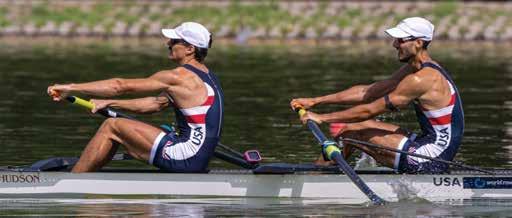
By definition, to relax means to slacken or make less rigid, to relieve nervous tension. Effective rowing technique requires economy of power over the race distance. The ability
Effective rowing technique requires economy of power over the race distance. Practicing proper lifting technique transfers well to the rowing stroke.
to contract and relax muscles alternately during the stroke cycle allows onegroup of muscles a brief respite while another group of muscles is working. It’s a form of rotating rest, a process that lessens the stress effect on your mind and body.
Gym work is an effective way to learn how to activate and deactivate muscles so that a lift is performed correctly. Practicing proper lifting technique transfers well to the rowing stroke. For example, when initiating a deadlift, the shoulder blades should be stable and packed. This requires the
trapezius muscles to be relaxed and the lats to be engaged in a position similar to how we connect to the handle at the beginning of the drive.
During the recovery, relaxation is active versus simply slack. You need to maintain composure and boat stability but also allow some tension relief for your body parts Rhythmic breathing is a powerful technique for relieving stress. Another technique is a quick body scan that combines breathing with progressive muscle relaxation.
At the finish position, exhale, relax your facial muscles, and let your hands weight the handle as your arms move away. Loosen your fingers once the oar is feathered in the oarlock or try simply lifting your pinky finger off the handle. Then rest your upper-body weight, sit tall, and allow the knees to rise softly so your legs can prepare for the next drive. Begin to inhale.
Notice when your feet contact the foot stretcher and begin to square the blade with the lightest of touch until you bury the blade, ready for the next drive.

Preaching the Value of Rowing
Amateur sports teach resilience, teamwork, independence, and leadership and create the kind of accomplished, loyal, giving alumni all colleges covet.
This winter, I had the good fortune of teaching a class on coaching at the Institute for Rowing Leadership at Community Rowing, Inc. It was energizing to work so closely with a group of young coaches at the start of their careers, guiding them through uncovering and strengthening their own identities as leaders. While we read a variety of academic articles, listened to podcasts, and watched TED Talks, we found that some of the most valuable time we spent in class was learning directly and personally from other rowing coaches.
This included a panel discussion on coaching philosophy with Al Acosta, head coach of the Cal women, Mike Gennaro, head coach of the Yale heavyweight men, and Kate Sweeney, head coach of the Ohio State women. All three coaches were at different stages in their careers, with differing backgrounds and influences on their paths to their current positions, but I
PHOTO: LISA WORTHY
TRAINING
COACH DEVELOPMENT
MARLENE ROYLE is the author of Tip of the Blade: Notes on Rowing. She specializes in training for masters rowers. Her coaching service, Roylerow Performance Training Programs, provides the program and support you need to improve your competitive edge. For information, email Marlene at roylerow@aol.com or visit www.roylerow.com.
TRAINING 62 APRIL 2024
Jackson Fuller (stroke) and Mason Banks, 2023 U23 world champions in the lightweight pair.

was struck, yet again, by the similarities. Good coaches do so many of the same things well, even if they do them in their own ways.
A theme well worth repeating is how important it is for coaches to create and communicate the value of being on their team and doing this sport—not only to recruits and members of the team but also, crucially, to stakeholders on campus. Al spoke clearly and strongly about his rowers learning just as much, if not more, from their time on the rowing team as they gain from their time in the classroom. He talked about rowing as a complement to the academic education they’re receiving, not a detriment.
As the ground beneath college sports shifts almost daily, it’s critical for the survival of rowing, and all Olympic sports, that coaches articulate the value that their teams bring to the college experience, since we aren’t bringing in the money obviously of the big-time spectator sports.
Amateur sports teach resilience, teamwork, independence, and leadership in practical, high-stakes ways that cannot be rivaled elsewhere on campus. They create the kind of accomplished, loyal, giving alumni all colleges covet.
If elite collegiate rowing is to continue to exist, it’s imperative that coaches become adroit and relentless in preaching the value of our sport for those who participate in it and the schools that sponsor it.
MADELINE DAVIS TULLY
 PHOTO: LISA WORTHY
PHOTO: LISA WORTHY
63 APRIL 2024
2023 Youth Nats-winning pair of Annika Nelson and Carline Krantz.


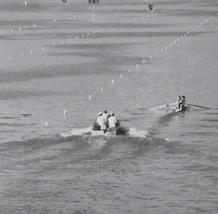


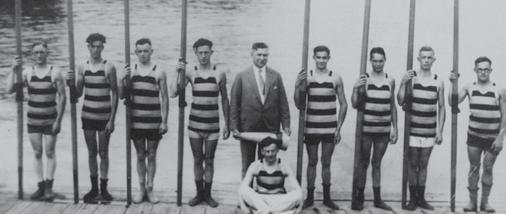


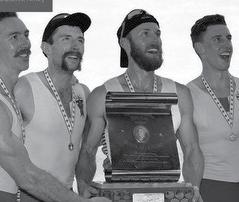
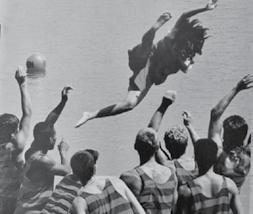
ROYAL CANADIAN HENLEY REGATTA
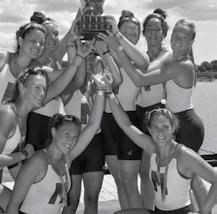
July 28–August 4, 2024
St. Catharines, Ontario, Canada
Entries open April 2024. Register your crews at henleyregatta.ca/registration
Follow web and social for important dates, accommodation and more information.
MASTERS
July 28
OPENING CEREMONY
July 29
RACE WEEK
July 30–Aug 4
henleyregatta.ca @HenleyRegattaCA



this remarkable event might now be decided and its lore diminished. That race and other very close races did raise the question of the evenness of the crews at the start. It was much the same when Harvard won the Olympic trials in 1968 by inches. Floating starts or the use of stake boats bouncing around surely made for inequalities there.”
The 1962 three-way tie is unique. Perhaps some alert reader will correct me, but I’ve never heard of another rowing race with a three-way tie for first place. A contemporary account (“the most exciting race at the EARC Sprints”) called it this way:
“Cornell and Navy both led three quarters into the race with MIT only one length behind. In the final stretch, the MIT boat comes from behind to produce the first, and only, three-way tie in EARC Sprints history.”
MIT was renowned for a terrific sprint and clearly had it on that day. It’s unusual in any very close race to find all onlookers agreeing on a finish, but in 1962, absent electronic timing (which would be introduced to rowing in 1964 at the Olympics), the finish-line judges got it as right as they could. It was decided that
each college would win three shirts from each of the others. MIT distributed its three Harvard shirts to its three seniors, its three Navies to its juniors, etc.
Hollywood would probably make Kozak and Henwood rivals in the three-way tie, rather than racing 16 years apart. But No. 6 and No. 1’s friendship over 25 years reminds us of the wonderful bonds that rowing creates.

DOCTOR ROWING CON’T FROM PAGE 66 >>> ADVERTISERS INDEX
Active Tools 31 Bont Rowing 24 Campus Quilt 26 Canadian Henley 64 Concept2, Inc 56 Durham Boat Company 4 Elite Rowing 15 Fluidesign 6..7 Gemini 68 Gladstone Clinic 26 GLRF 29 Hudson Boad Works 2..3 Leonard Insurance 65 Nielsen-Kellerman 5 Peinert Boatworks 10 Peterson Architects 30 Pocock Racing Shells 12 RegattaSport 63 Rowing Catalog 18..19 Shimano North America 13 SportGraphics 8..9 Swing Ventures 33 UVA 17 Vespoli USA 67 Wolfeboro Sculling School 17 65 APRIL 2024
DOCTOR ROWING
ANDY ANDERSON
‘It’s a Rower Thing’
It isn’t unusual for deep, lasting friendships to form in shells on and off the water. Most of the time these happen between rowers, but sometimes they happen between competitors.
Here at Rowing News , we received an email from a reader titled “An Amazing Race and a Rowing Friendship.” In it, Gerry Henwood wrote:
“I met Karl Kozak at a meeting in Cleveland, Ohio, where we shared the same role in sales management for a company specializing in liquidlevel measurement for boilers and other industrial vessels. Karl covered the western United States; I covered the Northeast. Karl was a U.S.Naval Academy graduate, Class of 1963. I was Syracuse University Class of 1980. Seventeen years separated us, but the age difference quickly melted away when we discovered we both were rowers.
“It was early in our friendship that Karl announced that he and two other crews won the same race, the varsity lightweight men’s eight in 1962, on Lake Quinsigamond at the Eastern Sprints in Worcester, Massachusetts. Karl was in the “engine room,” sitting in six seat. Needless to say, I was amazed that a three-way tie took place and impressed that Karl was in one of the boats. As the story goes, the officials were going to do the race over to determine a winner. The athletes challenged a do-over, and the rest is history. Three winners were declared.
“Certainly a recognition that we are in it together. That seems greatly advanced.”

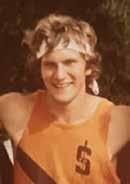
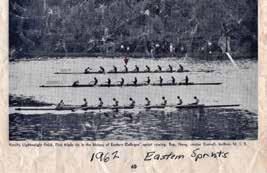
“Upon graduation, Karl qualified for nuclear submarines that patrol the North Atlantic. He was assigned to the U.S.S. Sculpin, a fast-attack submarine. He’s in chemotherapy treatment now for cancer.
“It’s a rower thing, I suppose, but he and I call each other by our seat number. I was the bowman of the 1978 Syracuse IRA-champion varsity eight, so I became No. 1. He is No. 6. It’s a rower thing. After 25 years, it’s more than friendship. We have bonded like brothers.”
It isn’t unusual that deep, lasting friendships are formed in shells on and off the water. Most of the time these happen between rowers who have been in the same boat or on the same team. But at times, this bond that Gerry Henwood speaks of happens between competitors.
Todd Jesdale, who coached the U.S. junior (now called U19) eight that won a gold medal said, “I think of a wonderful friendship that developed with Arno Siemes, the six man in the German youth eight in 1992. I was poking around to try to discover how those boys developed such fine sportsmanship and found Arno, the only one who was not from the former East Germany and who could speak English. “We were in contact for a long time; he visited with us in Cincinnati for a month or so—great for getting boats off the top racks. More and more, one sees high-level athletes hugging after the games, certainly a recognition that we are in it together. That seems greatly advanced over the cheap emotions we had in the old days, a real statement about competition being “between” and “with,” as in “a race with.” As opposed to “against.” “With” goes both ways.”
I had contacted Jesdale because he also happened to be a witness to that 1962 race, as he was coaching the freshmen lights at Cornell. Coaching in an era when we have access to photo-finish equipment, (in 2009, Doctor Rowing’s school crew missed the gold medal by .02 of a second; if it had been 1962, it undoubtedly would have been called a dead heat.) Jesdale said:
“The 1962 race was a real tie. There was a photo, the one you sent, up in the Cornell Boathouse, so I had lots of time to look at it. Soon after, regattas had photo timers, perhaps a loss, rather than a gain, since
CONTINUES ON PAGE 65 >>>
PHOTOS COURTESY GERRY HENWOOD.
66 APRIL 2024
Karl Kozak (top, left), Gerry Henwood, and the three-way tie.

Head of the Charles Champion, Women's Youth 4+ Connecticut Boat Club
4+ took
Medals from '23 Charles, Schuylkill, Fish, Hooch! www.vespoli.com
'23
VHP41+ VHP
home 27 Gold

Get started today at gemini.com
APRIL 2024 | VOLUME 31 NUMBER 03 The Safety Issue | Tom Rooks | Stanford Men






























































































 PHOTO: LISA WORTHY
PHOTO: LISA WORTHY
















